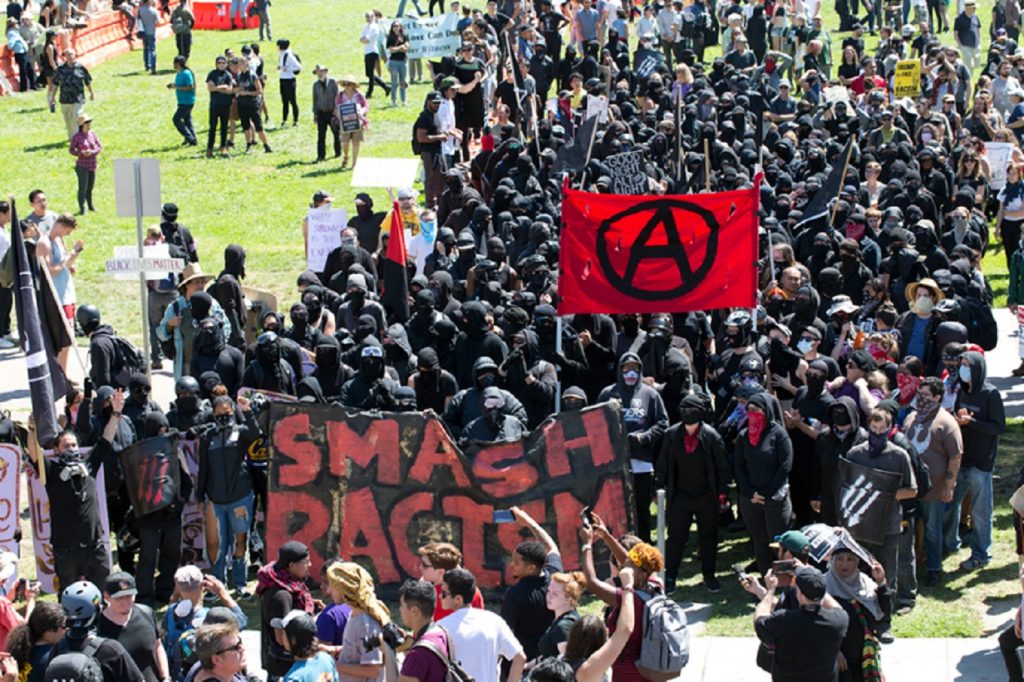
“First, the English word Antifa is a loanword from German, taken from an abbreviation of the word Antifaschistisch (“anti-fascist”) and the name of Antifaschistische Aktion. Antifa is not an interconnected or unified organization, but rather a movement without a hierarchical leadership structure, comprising multiple autonomous groups and individuals.” ref
“The antifa movement is composed of left-wing, autonomous, militant-anti-fascist groups and individuals. The principal feature of antifa groups is their use of direct action, with conflicts occurring both online and in real life. They engage in varied protest tactics, which include digital activism, property damage, physical violence, and harassment against those whom they identify as fascist, racist, or on the far-right. Activists involved in the movement tend to be anti-capitalistsand subscribe to a range of ideologies, typically on the left. They include anarchists, socialists and communists along with some liberals and social democrats. Their stated focus is on fighting far-right and white supremacist ideologies directly, rather than through electoral means. ” ref

Emergence in History of the Anti-Fascist Movement
“When Italian dictator Benito Mussolini consolidated power under his National Fascist Party in the mid-1920s, an anti-fascist movement surfaced both in Italy and countries such as the United States. Many anti-fascist leaders in the United States were syndicalist, anarchist, and socialist who emerged from Italy with experience in labor organizing and militancy.” ref
A Few Thoughts on Socialist Anarchism
“Social anarchism/ Socialist Anarchism is a non-state form of socialism and is considered to be the branch of anarchism that sees individual freedom as being interrelated with mutual aid. Social anarchist thought emphasizes community and social equality as complementary to autonomyand personal freedom through norms such as freedom of speech maintained in a decentralized federalism, balanced with freedom of interaction in thought as well as incorporating the concept of subsidiarity, namely “that one should not withdraw from individuals and commit to the community what they can accomplish by their own enterprise and industry” and that “[f]or every social activity ought of its very nature to furnish help to the members of the body social, [should] never destroy and absorb them”, or simply the slogan “Do not take tools out of people’s hands.” ref
“Social anarchism has also advocated that the conversion of a proportion of present-day and future productive private property be made into social property to offer individual empowerment through easier access to such as tools or parts, or a sharing of the commons while retaining respect for personal property.[9] The term is used to describe the theory—contra individualist anarchism—that places an emphasis on the communitarian and cooperative aspects in anarchist theory while also opposing authoritarian forms of communitarianism associated with groupthinkand collective conformity and instead favouring a reconciliation between individuality and sociality. For instance, illegitimate authority is removed through inspection and vigilance. While self-determination is asserted as is worker’s self-management and education and empowerment emphasized, both individually and through interaction with the community, a do-it-yourself (DIY) mentality is combined with educational efforts within the social realm.” ref
“Social anarchism is considered an umbrella term that includes—but it is not limited to—the post-capitalist economic models of anarcho-communism, collectivist anarchism and sometimes mutualism, or even non-state controlled federated guild socialist dual powerindustrial democracyand economic democracy or federated worker cooperatives in addition to workers’ and consumers’ councils, replacing much of the present state system yet still retaining basic rights as well as the trade union approach of anarcho-syndicalism, the social struggle strategies of platformism and specifism and the environmental philosophy of social ecology. The term social anarchism is often used interchangeably with libertarian socialism or left-libertarianism and emerged in the late 19th century as a distinction from individualist anarchism.” ref
The “Anti-Fascist” Movement
“Moreover, the “anti-fascist” movement’s short but inspiring political legacy proved too uncomfortable for both Cold War-era German states, and was ignored in schools and mainstream history. Today its legacy is almost entirely lost to the Left.” ref
“On the Left, many Communists and Social Democrats had either been outright murdered by the Nazis, or died in the ensuing war. The unimaginable human and material destruction wrought by Nazi rule killed millions and turned German society upside down, decimating the labor movement and murdering most of the country’s Jewish population. Millions who had supported or at least acquiesced to the regime — including many workers and even some former socialists — now faced a new beginning in unknown political terrain.” ref
“Yet despite its failure to stop Hitler in 1933 and veritable dismantling in subsequent years, Germany’s socialist labor movement and its decidedly progressive traditions outlived Hitler in the factories of its industrial cities, and began gathering up the fragments as soon as open political activity became possible. As historian Gareth Dale describes:
Of all sectors of the population, it was industrial workers in the major towns that showed the greatest immunity to Nazism. Many trade unionists and socialists were able to maintain their traditions and beliefs, at least in some form, through the Nazi era. A courageous minority, including some 150,000 Communists, took part in illegal resistance. Wider layers avoided danger but were able to keep labour movement values and memories alive amongst groups of friends, in workplaces and on housing estates.” ref
“These groups, oftentimes launched from the aforementioned housing estates, were generally called “Antifaschistische Ausschüsse,” “Antifaschistische Kommittees,” or the now famous “Antifaschistische Aktion” – “Antifa” for short. They drew on the slogans and orientation of the prewar united front strategy, adopting the word “Antifa” from a last-ditch attempt to establish a cross-party alliance between Communist and Social Democratic workers in 1932. The alliance’s iconic logo, devised by Association of Revolutionary Visual Artists members Max Keilson and Max Gebhard, has been since become one of the Left’s most well-known symbols.” ref
“After the war, Antifas varied in size and composition across the former Reich, now divided into four zones of occupation, and developed in interaction with the local occupying power. Emerging seemingly overnight in dozens of cities, most formed immediately after Allied forces arrived, while some such as the group in Wuppertal “liberated” themselves in street battles with Hitler loyalists before the Allies could.” ref
“When Italian dictator Benito Mussolini consolidated power under his National Fascist Party in the mid-1920s, an oppositional anti-fascist movement surfaced both in Italy and countries such as the United States. Many anti-fascist leaders in the United States were syndicalist, anarchist, and socialist émigrés from Italy with experience in labor organizing and militancy.” ref
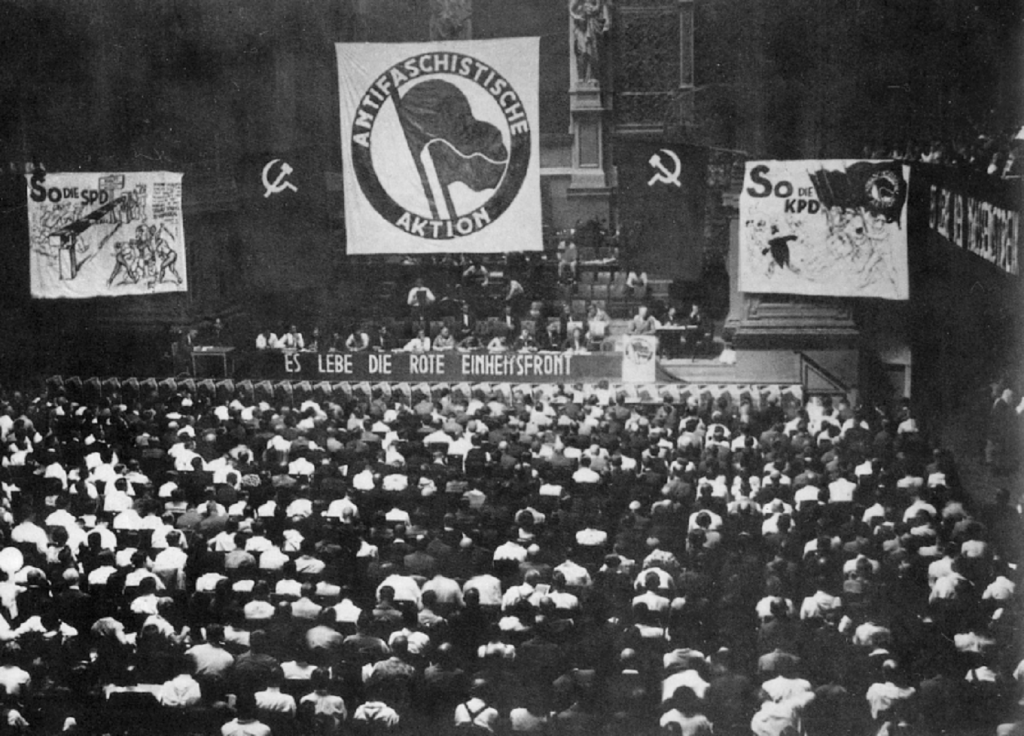
“Scene from the 1932 Antifaschistische Aktion conference”
“After the war, Antifas varied in size and composition across the former Reich, now divided into four zones of occupation, and developed in interaction with the local occupying power. Emerging seemingly overnight in dozens of cities, most formed immediately after Allied forces arrived, while some such as the group in Wuppertal “liberated” themselves in street battles with Hitler loyalists before the Allies could.” ref
“Pivotally, these circles were not spontaneous instances of solidarization between traumatized war survivors, but the product of Social Democratic Party (SPD) and Communist Party (KPD) veterans reactivating prewar networks. Albrecht Lein reports that the core of the Braunschweig Antifa was made up of KPD and SPD members in their forties and fifties who had avoided the front, though Catholic workers’ organizations and other forces were also involved.” ref
“The Antifa groups numbered between several hundred and several thousand active members in most cities, while the openly decried lack of youth involvement can be ascribed to twelve years of Nazi education and socialization, which annihilated the once widespread proletarian-socialist attitude among most young Germans. Though the material needs of war and reconstruction incorporated women into economic life in new ways, the male dominance characteristic of German society at the time was also reflected in the Antifa movement, which consisted largely (but not entirely) of men.” ref
“Antifas tended to focus on a combination of hunting down Nazi criminals and underground Nazi partisans (the so-called “Werewolves”) and practical concerns affecting the general population. Braunschweig’s Antifa, for example, printed a twelve-point program demanding, among other things, the removal of Nazis from all administrative bodies and their immediate replacement with “competent antifascists,” liquidation of Nazi assets to provide for war victims, emergency laws to prosecute local fascists, and the reestablishment of the public health-care service. Typical of an organization led by socialists and thus keenly aware of the need for print media as an organizing medium, the program’s twelfth and final point consisted bluntly of a “Daily newspaper.” ref
“Although surviving records indicate that many Antifas were dominated by the KPD, the political mood in the early months was far from the “Third Period” adventurism of the late Weimar period. Across the board, local Antifas were motivated by a desire to learn from the mistakes of 1933 and build a non-sectarian labor movement bridging divisions. This was buoyed by a widespread sense at the war’s end that the horrors of Nazism had been a result of the instability and inequality of capitalism, and that a new, egalitarian economic system was needed for the postwar order.” ref
“Demands for nationalization of industry and other left-wing policies were widespread. Even the forced marriage between KPD and SPD into the Socialist Unity Party (SED) in the Soviet zone drew on this sentiment and recruited many former oppositionists in the first year. In British-occupied Hamburg, a joint KPD-SPD action committee convened in July 1945 with broad support from their respective memberships to declare:
The will to merge into a powerful political party lives in the hearts of the millions of supporters of the once warring German workers’ parties as the most meaningful outcome of their shared suffering. This desire is deeply etched into all of the surviving prisoners from the concentration camps, prisons, and Gestapo institutions.” ref
“The rest of the document consisted of practical demands around which to unite Hamburg’s fragmented labor movement. Antifas enjoyed varying degrees of success depending on the composition of the local movement and the amount of leeway allowed to them by occupying powers. Despite forming outside of the Allied administration and pushing forward popular de-Nazification policies against occupying forces who sought reconciliation with the old authorities, they were in no position to contest Allied hegemony and represented militant minorities at best.” ref
“The southwestern industrial city of Stuttgart, for example, was fortunate enough to be involved in territorial maneuvering between the United States and France, which occupied the city preemptively. Keen to avoid civil unrest and thus give the Americans a pretext to take it back, French authorities allowed Stuttgart’s antifascists considerable leeway in dismantling the Nazi-era German Labor Front (DAF), rebuilding shop-floor organization in the factories, and organizing the population in cross-party antifascist alliances.” ref
“Ideologically, antifa in America sees itself as the successor to anti-Nazi activists of the 1930s; European activist groups that originally organized to oppose World War II-era fascist dictatorships re-emerged in the 1970s and 1980s to oppose white supremacy and skinheads and eventually spread to America. After World War II, but prior to the development of the modern antifa movement, violent confrontations with fascist elements continued sporadically.” ref
“Modern antifa politics can be traced to opposition to the infiltration of Britain’s punk scene by white power skinheads in the 1970s and 1980s, and the emergence of neo-Nazism in Germany following the fall of the Berlin Wall. In Germany, young leftists, including anarchists and punk fans, renewed the practice of street-level anti-fascism. Columnist Peter Beinart writes that “in the late ’80s, left-wing punk fans in the United States began following suit, though they initially called their groups Anti-Racist Action (ARA) on the theory that Americans would be more familiar with fighting racism than they would be with fighting fascism.” ref
“Dartmouth College historian Mark Bray, author of Antifa: The Anti-Fascist Handbook, credits ARA as the precursor of the modern US antifa groups in the United States and Canada. In the late 1980s and 1990s, ARA activists toured with popular punk rock and skinhead bands in order to prevent Klansmen, neo-Nazis and other assorted white supremacists from recruiting. Their motto was “We go where they go” by which they meant that they would confront far-right activists in concerts and actively remove their materials from public places.” ref
“In 2002, the ARA disrupted a speech in Pennsylvania by Matthew F. Hale, the head of the white supremacist group World Church of the Creator, resulting in a fight and twenty-five arrests. One of the earliest antifa groups in the U.S. was Rose City Antifa, which was formed in Portland, Oregon in 2007. Other antifa groups in the U.S. have other genealogies, for example in Minneapolis, Minnesota, where a group called the Baldies was formed in 1987 with the intent to fight neo-Nazi groups directly.” ref
“The Anti-Defamation League makes a point that the label “antifa” should be limited to “those who proactively seek physical confrontations with their perceived fascist adversaries,” and not be misapplied to include all counter-protesters. Moreover, the Anti-Defamation League stated that “All forms of antifa violence are problematic. Images of these ‘free speech’ protesters being beaten by black-clad and bandana-masked antifa provide right wing extremists with a powerful propaganda tool” but goes on to state “that said, it is important to reject attempts to claim equivalence between the antifa and the white supremacist groups they oppose.” They also mention that “most established civil rights organizations criticize antifa tactics as dangerous and counterproductive.” ref

Antifa Activism
Antifa groups, along with black bloc activists, were among those who protested the 2016 election of Donald Trump. They also participated in the February 2017 Berkeley protests against alt-right speaker Milo Yiannopoulos, where they gained mainstream attention, with media reporting them “throwing Molotov cocktails and smashing windows” and causing $100,000 worth of damage.” ref
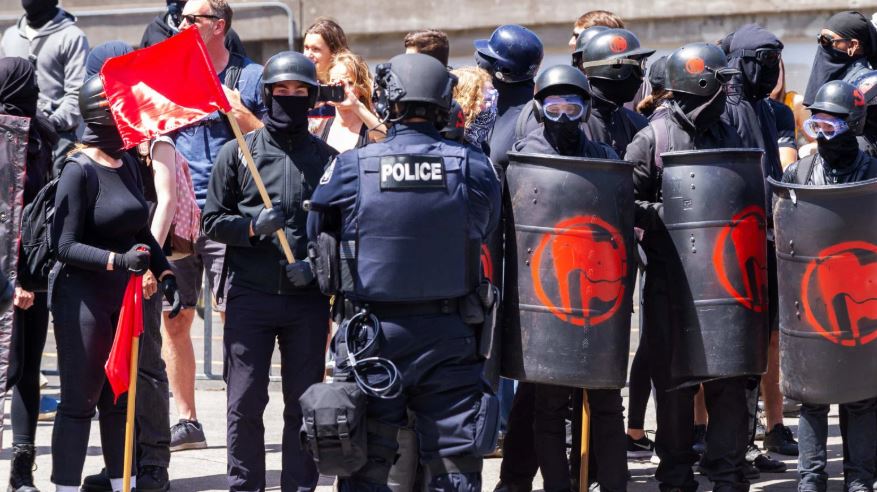
A Little on the History of Black Bloc
“A black bloc is a tactic used by groups of protesters who wear black clothing, ski masks, scarves, sunglasses, motorcycle helmets with padding, or other face-concealing and face-protecting items. This tactic was developed in response to increased use of police force following the 1977 Brokdorf demonstration. When Ronald Reagan came to Berlin in June 1987, he was met by around 50,000 demonstrators protesting against his Cold War policies. This included a black bloc of 3,000 people. In the period after the Berlin Wall, the German black bloc movement continued traditional riots such as May Day in Berlin-Kreuzberg, but with decreasing intensity. Their main focus became the struggle against the recurring popularity of Neo-Nazism in Germany.” ref
“The first prominent use of the tactic in United States of America occurred at the Pentagon, in Washington, D.C. on 17 October 1988, although anarchists had been using similar tactics in small numbers in preceding years in places like San Francisco, culminating with several hundred anarchists in black smashing glass storefronts and attacking vehicles in the Berkeley Anarchist Riot of 1989. In D.C., over one thousand demonstrators—a small number consisting of a black bloc—called for the end to U.S. support for the right-wing death squads in El Salvador. A black bloc caused damage to property of GAP, Starbucks, Old Navy, and other retail locations in downtown Seattle during the 1999 anti-WTO demonstrations. They were a common feature of subsequent anti-globalization protests.” ref
“In April 2017, two groups described as “anti-fascist/anarchist”, including the socialist/environmentalist Direct Action Alliance, threatened to disrupt the 82nd Avenue of Roses Parade after hearing the Multnomah County Republican Party would participate. The parade organizers also received an anonymous email, saying: “You have seen how much power we have downtown and that the police cannot stop us from shutting down roads so please consider your decision wisely”. The two groups denied having anything to do with the email. The parade was ultimately canceled by the organizers due to safety concerns.” ref

Back to Antifa Activism
“On June 15, 2017, some antifa groups joined protestors at The Evergreen State College to oppose the far-right group Patriot Prayer’s event. Patriot Prayer was supporting biology professor Bret Weinstein who became the central figure in a controversy after he criticized changes to one of the college’s events. In addition to peaceful antifa activists who held up a “community love” sign, USA Today reported that one slashed the tires of far-right activist Joey Gibson and another was wrestled to the ground by Patriot Prayer activists after being seen with a knife.” ref
“Antifa counter-protesters at the 2017 Unite the Right rally in Charlottesville, Virginia in August 2017 “certainly used clubs and dyed liquids against the white supremacists”. Journalist Adele Stan interviewed an antifa protester at the rally who said the sticks carried by the protesters are a justifiable countermeasure to the fact that “the right has a goon squad”. Some antifa participants at the Charlottesville rally chanted that counter-protesters should “punch a Nazi in the mouth”. Antifa participants also protected Cornel West and various clergy from attack by white supremacists, with West stating he felt that antifa had “saved his life”. Antifa activists also defended the First United Methodist Church, where the Charlottesville Clergy Collective provided refreshments, music, and training to the counter-protesters and, according to a local rabbi, “chased [the white supremacists] off with sticks.” ref
“Apart from the other activities, antifa activists engage in mutual aid, such as disaster response in the case of Hurricane Harvey. According to Natasha Lennard in The Nation, as of January 2017 antifa groups were working with interfaith groups and churches “to create a New Sanctuary Movement, continuing and expanding a 40-year-old practice of providing spaces for refugees and immigrants”. Antifa activists also do research to monitor and track the “methods and movements of far-right leaders”, hold conferences and workshops on anti-fascist activism, and advocate ways of “fostering sustainable, peaceful communities”, such as “tending neighborhood gardens and setting up booths at book fairs and film festivals” where they provide printed materials.” ref
“Groups that had been preparing to protest the Boston Free Speech Rally saw their plans become viral following the violence in Charlottesville. The event drew a largely peaceful crowd of 40,000 counter-protestors. In The Atlantic, McKay Coppins stated that the 33 people arrested for violent incidents were “mostly egged on by the minority of ‘Antifa’ agitators in the crowd”. President Trump described the protestors outside his August 2017 rally in Phoenix, Arizona as “antifa.” ref
“During a Berkeley protest on August 27, 2017, an estimated one hundred antifa protesters joined a crowd of 2,000–4,000 counter-protesters to confront alt-right demonstrators and Trump supporters who showed up for a “Say No to Marxism” rally that had been cancelled by organizers due to security concerns. Protestors threatened to smash the cameras of anyone who filmed them. Jesse Arreguin, the mayor of Berkeley, suggested classifying the city’s antifa as a gang. The far-right group Patriot Prayer cancelled an event in San Francisco the same day following counter protests. Joey Gibson, the founder of Patriot Prayer, blamed antifa, along with By Any Means Necessary (BAMN), for breaking up the event.” ref
“In November 2018, police investigated the antifa group Smash Racism D.C. following a protest outside the home of The Daily Caller founder Tucker Carlson.[84] Activists of the group said through a bullhorn that Carlson was promoting hate and chanted, “We will fight, we know where you sleep at night!” and defaced the driveway of Carlsons’ property by spray-painting an anarchist symbol onto it Twitter suspended the group’s account for violation of Twitter rules by posting Carlson’s home addresses. The group also posted addresses of Carlson’s brother and a friend who co-founded The Daily Caller.” ref
“In February 2019, anti-fascist activists marched in celebration through Stone Mountain, Georgia as a white supremacist, neo-confederate rally planned to be held at the adjacent Stone Mountain Park was cancelled due to infighting and fear of personal safety. White supremacist groups originally sought to attract attention by marching at the Stone Mountain, a Confederate landmark carving, during the Super Bowl weekend. The groups ignored the park’s denial of permit due to “clear and present danger to the public health or safety”, but was thwarted when Facebook and Twitter terminated their organizing accounts and pages, and one group leader’s retreat due to “fears of violence from counter-protesters”. In their absence, more than 100 antifa activists marched peacefully through the adjacent village, burned a Klansman effigy and chanted slogans such as “Good night, alt right” and “Death to the Klan”, before joining another civil rights rally at Piedmont Park held by the NAACP and the SPLC.” ref
The Philosophy of Antifa by Philosophy Tube
American Government Response to Antifa Activism
“A government does not always announce that they have become fascist, they may simply announce that anti-fascists are enemies of the state.” – Marco Leone
“In June 2017, the antifa movement was linked to “anarchist extremism” by the New Jersey Office of Homeland Security and Preparedness. This assessment was replaced with one in 2019 which states that “Antifa is a movement that focuses on issues involving racism, sexism, and anti-Semitism, as well as other perceived injustices. The majority of Antifa members do not promote or endorse violence; however, the movement consists of anarchist extremists and other individuals who seek to carry out acts of violence in order to forward their respective agendas.” ref
“In September 2017 Politico obtained confidential documents and interviews indicating that in April 2016, the U.S. Department of Homeland Security and the Federal Bureau of Investigation believed that “anarchist extremists” were the primary instigators of violence at public rallies against a range of targets. Politico interviewed unidentified law enforcement officials who noted a rise in activity since the beginning of the Trump administration, particularly a rise in recruitment (and on the part of the far-right as well) since the Charlottesville Unite the Right rally.” ref
“One internal assessment acknowledged an inability to penetrate the groups’ “diffuse and decentralized organizational structure”. By 2017, the FBI and DHS reported that they were monitoring suspicious antifa activity in relation to terrorism. In August 2017 a petition was lodged with the White House petitioning system “We the People” calling upon the government to formally classify “AntiFa” as terrorist. The White House responded in 2018 that federal law does not have a mechanism for formally designating domestic terrorist organizations. The writer of the petition later said he had created it to “bring our broken right side together,” and to “prop up antifa as a punching bag.” ref
“Antifa actions have been subject to criticism from Republicans, Democrats and political commentators in the U.S. media. House Minority Leader Nancy Pelosi condemned the violence of antifa activists in Berkeley on August 29, 2017. Conservative talk show host and Fox News contributor Laura Ingraham suggested labeling antifa as a terrorist organization. Noam Chomsky described them as “a major gift to the right”. Other “anti-anti-fascists” on the left have argued that antifa attack a symptom of liberal democracy rather than combating structural racism itself, and in doing so distance themselves from revolutionary politics. Dissent editor Michael Kazin stated “Non-leftists often see the left as a disruptive, lawless force. Violence tends to confirm that view.” The historian Ruth Ben-Ghiat said in July 2019 that “Throwing a milkshake is not equivalent to killing someone, but because the people in power are allied with the right, any provocation, any dissent against right-wing violence, backfires”, with the effect that “[m]ilitancy on the left” can “become a justification for those in power and allies on the right to crack down” on the left.” ref
“On the other hand, historian and political organizer Mark Bray has said “Given the historical and current threat that white supremacist and fascist groups pose, it’s clear to me that organized, collective self-defense is not only a legitimate response, but lamentably an all-too-necessary response to this threat on too many occasions.” Alexander Reid Ross, a lecturer in geography and an author on the contemporary right, has said that antifa groups represented “one of the best models for channeling the popular reflexes and spontaneous movements towards confronting fascism in organized and focused ways.” Eleanor Penny, an author on fascism and the far-right, argues against Chomsky that “physical resistance has time and again protected local populations from racist violence, and prevented a gathering caucus of fascists from making further inroads into mainstream politics.” Cornel West, who attended a counter-protest to the Unite the Right rally, said in an interview, “we would have been crushed like cockroaches if it were not for the anarchists and the anti-fascists,” describing a situation where a group of 20 counter-protesters were surrounded by marchers who he described as, “neofascists.” ref
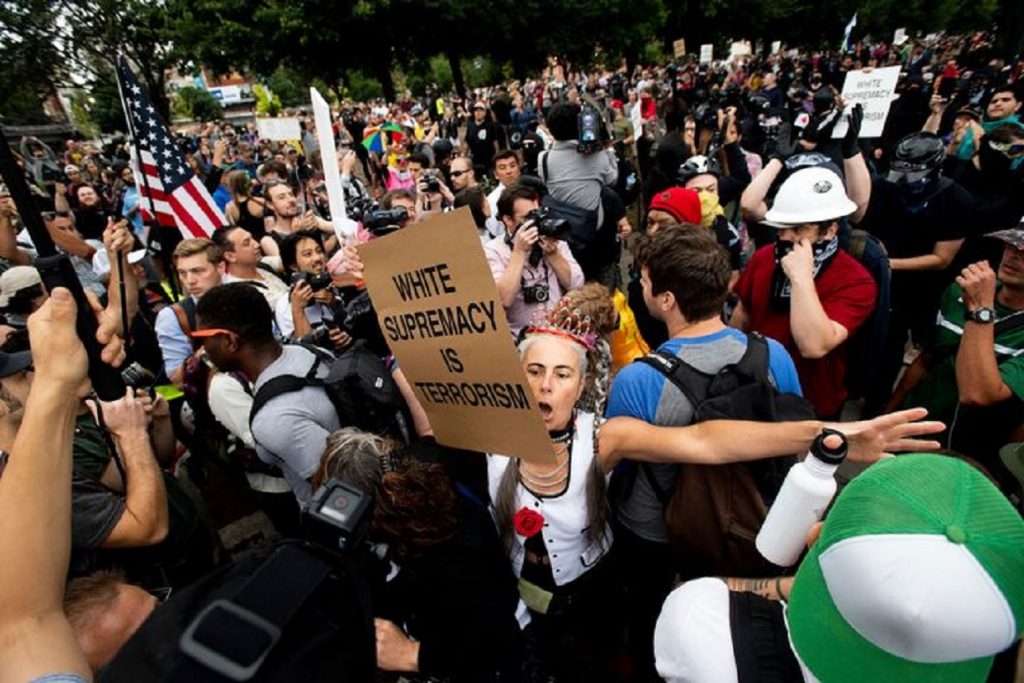
ASSOCIATED PRESS – A counter-protester at a Proud Boys rally in Portland, Oregon, on Saturday.
Proud Boys, Outnumbered By Anti-fascists, Get Police Escort After 30-Minute Rally
“Many had feared the rally in Portland would be the most violent fascist rally of the Trump era. A few hundred fascists once again invaded Portland for a much-anticipated rally Saturday, but this time were mostly deprived of the violent spectacle they crave, as a much larger group of anti-fascists made them know they weren’t welcome in this city. The fascists belonged to far-right groups including the Proud Boys, Patriot Prayer, and the Three Percenters. And whereas at previous Portland rallies these groups have often confronted and attacked anti-fascist protesters, this time they were barely given the chance to do so. Upon arriving at Tom McCall Waterfront Park around 11.am. Saturday, they were kept separated from their foes by concrete barriers and a phalanx of police. The fascists ambled about, singing the national anthem and chanting “USA” for a mere 30 minutes before deciding it was time to leave.” ref
“There were concerns, after all, that this rally would be Portland’s most violent since President Donald Trump took office. Portland officials have for years allowed the Proud Boys and their buddies in the Washington state-based extremist faction Patriot Prayer to hold “free speech” gatherings here that have served as nothing more than thinly veiled excuses to fight leftists in the city’s streets. But the messaging leading up to this particular rally carried an air of vengeance. Proud Boys billed it as direct action against anti-fascists in response to an incident at a June rally that left far-right blogger Andy Ngo with a black eye. Although bloodied faces have become the norm at these rallies, Ngo’s injuries quickly made him into a cause celebre among the far right, which is eager to depict anti-fascism as a violent movement worthy of government repression.” ref
“Early Saturday morning before the rally, the Proud Boys received a big endorsement for their cause. “Major consideration is being given to naming ANTIFA an ‘ORGANIZATION OF TERROR,’” the president tweeted. “Portland is being watched very closely. Hopefully, the Mayor will be able to properly do his job!” “Antifa” is a blanket term that refers to a decentralized network of leftist, anti-fascist organizations, some of whose members wear masks and dress in all black at political rallies. Hours after the president’s tweet, over a thousand anti-fascist protesters gathered in Tom McCall Waterfront Park to hold a rally of their own.” ref
“One of their stated goals ahead of the rally was to destigmatize the word “antifa” itself, which right-wing figures and media outlets like Fox News have turned into a scare word. Popular Mobilization (or PopMob), a coalition of leftist groups that organized the counterprotest, distributed flyers in Portland this week that stated: “If you oppose racism, white supremacy, homophobia, transphobia, misogyny, Islamophobia, anti-Semitism, and the xenophobic, ultranationalist ideologies of the far-right (and our current administration), you are an EVERYDAY ANTIFASCIST.” “If you are not a fascist — then you are Antifa,” it continued.” ref
“One anti-fascist in the crowd Saturday was a 47-year-old office administrator named Shane. He held a sign reading “Say Her Name” next to a photo of Heather Heyer, the counterprotester murdered by a neo-Nazi at 2017’s “Unite The Right” rally in Charlottesville, Virginia. “If we ignore fascism, it emboldens fascism, and we must confront fascism with all necessary force, even if that just means showing up and saying, ‘You’re not welcome here,’” Shane told HuffPost.” ref
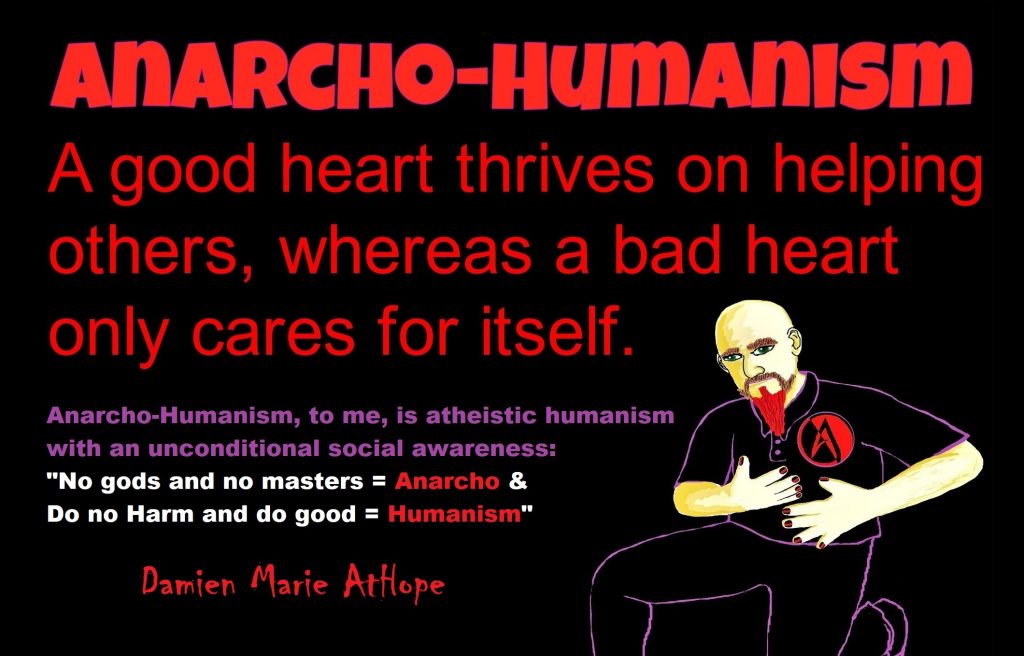
I am a proud socialist anarchist (though I am more accurately an anarcho-humanist)
I am also an out leftist radical who is proudly anti-fascist!!!
I support Antifa apposing fascism but I appose Antifa doing acts of unprovoked violence and aggression. On that point I have heard some say damage to properly is violence… No, I do not agree.
To me, there is no such thing as violence committed against property only against people. So I don’t consider any amount of property damage to be “violence”, sure it’s property damage that is all, it can be for good or bad reasons. Even cause distress but it still doesn’t make it “violence.”No more than cutting down a tree is thought as murder nor assault and battery, it’s not a being nor does it have any dignity to violate. Thus, as a thing, it’s being damaged may involve aggression, as well as a form of harm it is just not violence and neither, is the aggression and harm of property “violence.”
My Anarcho-Humanism:
- We are all one connected human family.
- No one owns the earth.
- If you can’t trust people with freedom how can you trust them with power?
Authoritarian Truth Seekers and Anti-Authoritarian Truth Seekers?
What inspires my anarcho-humanism has three core truths to my ethical anarchist persuasion:
1. We are all one connected human family, proven by DNA showing we should treat each other as fellow dignity beings, supported equally (no gods and no masters = “Anarcho”).
2. No one owns the earth, we may make claims to it even draw lines on maps thinking this makes the fantasy borders, illusion supported by force and the potential for threat. Thus the ethical truth is we need to share the earth as communally as possible. And use the resources as safe and ethically as possible striving towards sharing and caring. (do no Harm and do good = Humanism)
3. If you can’t trust people with freedom how can you trust them with power? Government is only as good as what they provide but I don’t trust ones that have rights over my body. How much more of a violation do you need to show their harm? I am not anti-society, I value good governance just don’t need the extra dead weight of government. There is not one thing a government is valued for that a non-government group with the same financial support and resources could not also do. I get we rise by helping each other and supporting universal betterment and human flourishing. Helping is Helpful: Valuing, Motivating, Supporting humanity is limited by nationalism and the, us Vs them, as if you should feel connected to only a few humans just because people invented the mental concept of land ownership, you mean you assert that you will harm others for an amount of the earth’s surface. Seeing with anarcho-humanism eyes helps you see how to Grow in Our Positive Outcomes: Gratitude, Empathy, and Kindness. We can become a more quality person by actively being aware and developing a gratitude for life, which supports as well as grows our feelings of empathy, that then motivates the behavior of kindness. And kindness flourishes in openness and freedom. (No gods no masters as well as do no harm and do good = Anarcho-humanism)
HUMANISM: the philosophic thinking that humans can solve human problems by human means, without feeling a need to appeal to the likes of holy books, mystical anything, nor the belief in gods or religions. But, instead, aspires to a true belief in humanity, viewing it with a persuasion of equality. This caring realist thinking found in humanism utilizes an unstated assumption or aspiration, to do no harm as much as posable and to do good whenever one can.
As an Anarcho-Humanist, I am a Global Citizen
I am not an “American First” (which too many seems like America only) putting natalism above all. I am a global citizen first. I am not an American first, as I see humanity hindered in its value if it strongly puts nationalism over humanism. I do not have a problem with others liking their country but when this like creates a superior or dislike of all other countries then I do look down on that. We are truly one people one world, you all are a valued part of my shared and connected humanity only ignorance and hate of this humanistic awareness stands in our way to making a better world for all.
I am relatively classed as a socialist-collectivist-mutualist-anarchist. And a feminist-queer-anarchist as well as my own label for roughly all the above-called, Anarcho-Humanism.”
Rationalism, Freethinker, Humanism & Secular humanism?
My core definition of humanism is that humans can solve human problems by human means. I am not saying other things can’t or shouldn’t be added to it but to me, a definition of humanism must always contain something coherent to such a thinking or not contradict such as I have offered. Thus, why it is appropriate to say “good without god” when one is a humanist.
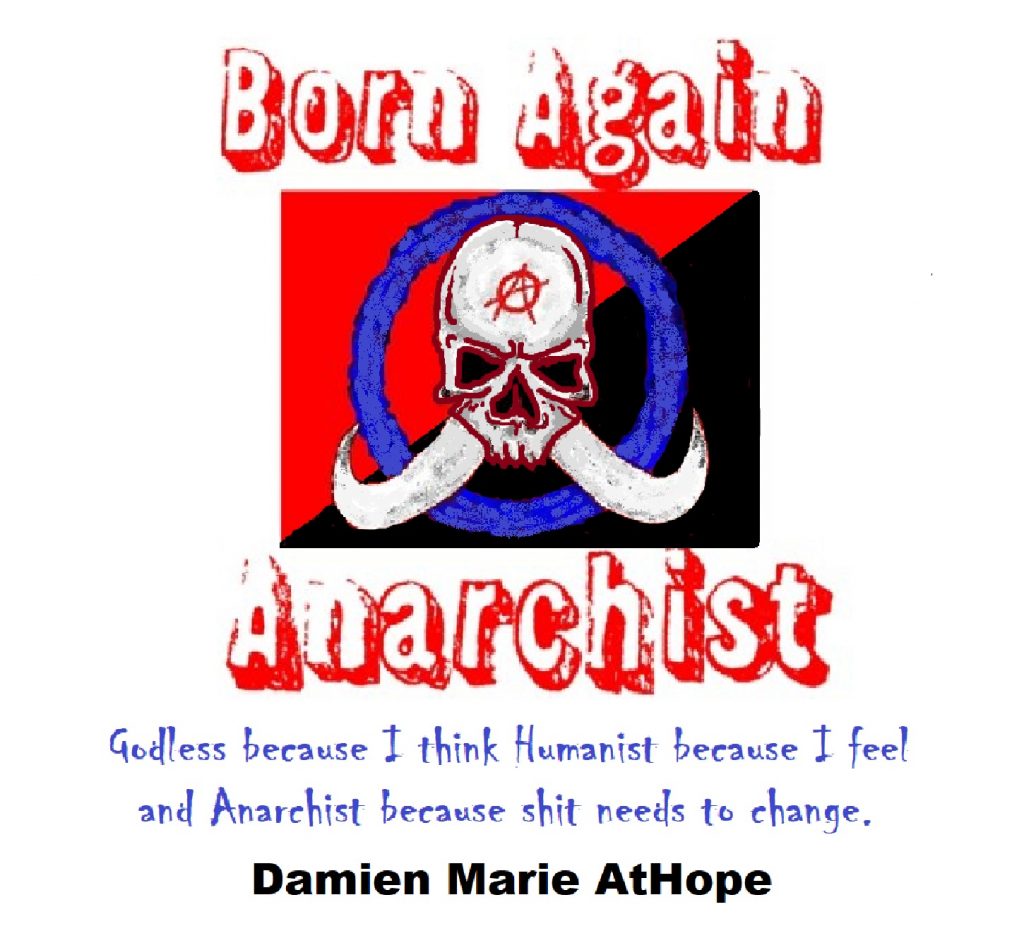
Standing up as an Atheist Anarchist
“Damien, I miss you just posting atheist stuff” – Atheist Commenter
What I hear:
“Damien, I want you to be limited and uncaring to the external threats in life. And I want you to be this way so I don’t have to care. Thus can you please stop caring as well as limiting your self and your humanity by posting only atheist stuff”
No, I will not do that as being an out anarchist (anarcho-humanist) is important to me, don’t like it leave my page as if you want me to choose it or atheism I would focus only on anarchism and stop my atheist activism. But thankfully, I am not a limited person as I see it is my firebrand atheism is a big part of my anarchist activism as how can I get others to care if they are not working in reality or looking for reality only solutions to even see a need to care. So when I am told to stop my anarchism I consider blocking that person as they are toxic in my life, as they are obviously not a true friend.
I speak out as an atheist anarchist for three main reasons, 1. to add facts and reason so those people that need them can find them, 2. to challenge flawed thinking of people and 3. to try and set a good example of how we can thoughtfully address problems and yet do it in a thoughtful way to inspire positive change. I, as a “leftist” anarchist-collectivist-mutualist-socialist and I fight for humanity, not nationalism. Thus, I can’t stand how deeply capitalist or neocon rightist some atheists can be. It is a real problem in our Atheist movement, especially after Trump. I have blocked a shirt load of them. We fight fanatics in religion and from the right.
Chase Fillingame “Yes, it is a major problem. I think a lot of them use hatred for religions like Islam to justify an aggressive foreign policy. They don’t see all people as human beings with valuable lives, but rather some lives are apparently less valuable if they grew up in a culture with Islam. And we apparently get to do what we want with them. There is also been a lot of anti-leftist rhetoric, mostly in the YouTube “sceptic” community. “Anti-sjw” nonsense.”
Ethics before Ego
How we treat others is often not just about them but also about us. Who we are should not flutter as if it is blowing in the wind. As if you lack control or a will of your own. We must put ethics before ego or we are going to be opening the door for errors in ethics. We should not let anger be our task manager nor allow anger to become an unethical behavior. When I was young, I was not shown the beauty of kindness. Now that I understand, I can’t imagine a beautiful life without it.
Stop pretending your racism, sexism, homophobia, and transphobia is somehow a love of one’s country. One can hold many strong beliefs in life and may at least one, be the need for kindness. Richness in life is more fully realized when one gets that the value of people is intrinsic, unlike the extrinsic value of things. Be better than the world around you. Yes, be the difference and change the world for the better.One who masters their ego and is not run by one’s Ego is expressing that one has reached self-mastery.
Character is the manifestation of an honorable heart intent on reason. One who masters their ego and is not run by one’s Ego is expressing that one has reached self-mastery. Ethics before Ego or Libido. Be as a light, that lovingly shines the glory of supported and justified truth. Be better than the world around you. Yes, be the difference and change the world for the better.
“Are We Good Enough” by Pyotr Kropotkin
“One of the commonest objections to Communism is, that men are not good enough to live under a Communist state of things. They would not submit to a compulsory Communism, but they are not yet ripe for free, Anarchistic Communism. Centuries of individualistic education have rendered them too egotistic. Slavery, submission to the strong, and work under the whip of necessity, have rendered them unfit for a society where everybody would be free and know no compulsion except what results from a freely taken engagement towards the others, and their disapproval if he would not fulfil the engagement. Therefore, we are told, some intermediate transition state of society is necessary as a step towards Communism. Men are not good enough for Communism, but are they good enough for Capitalism? If all men were good-hearted, kind, and just, they would never exploit one another, although possessing the means of doing so. With such men the private ownership of capital would be no danger. The capitalist would hasten to share his profits with the workers, and the best-remunerated workers with those suffering from occasional causes. If men were provident they would not produce velvet and articles of luxury while food is wanted in cottages: they would not build palaces as long as there are slums. If men had a deeply developed feeling of equity they would not oppress other men.” ref
I would rather die doing that which is right than live a life that is wrong! I am for non-aggression, I am not a pacifist. As such I support measured, reasoned, and limited violence or aggression for direct self-defense or other-defense. Be a voice for the voiceless and fight for the human rights of everyone. We rise by helping each other. Yes, I am responsible.
Universal ethics?
“Universal ethics: There are several ethical standards that are considered to be self-evident, and seem to apply to all people throughout all of history, regardless of cultural, political, social, or economic context. The non-aggression principle, which prohibits aggression, or the initiation of force or violence against another person, is a universal ethical principle. Examples of aggression include murder, rape, kidnapping, assault, robbery, theft, and vandalism. On the other hand, the commission of any of such acts in response to aggression does not necessarily violate universal ethics. ref
There are obvious reasons why universal ethics are beneficial to society. For example, if people were allowed to kill or steal, this would lead to widespread chaos as well as violence and would be detrimental to the well-being of society. Most people agree that it’s better to prohibit aggression than to allow everyone to commit it. Therefore, aggression is intrinsically immoral. Although nearly all societies have laws prohibiting aggression, this does not mean that universal ethics are necessarily reflected by that society’s government or its dominant ideology. ” ref
There are several ethical standards that are considered to be self-evident and seem to apply to all people throughout all of history, regardless of cultural, political, social, or economic context. The non-aggression principle, which prohibits aggression, or the initiation of force or violence against another person, is a universal ethical principle. My Examples of aggression include murder, rape, kidnapping, assault, robbery, theft, and vandalism. On the other hand, the commission of any of such acts in response to aggression does not necessarily violate universal ethics. There are obvious reasons why universal ethics are beneficial to society. For example, if people were allowed to kill or steal, this would lead to widespread chaos and violence and would be detrimental to the well-being of society. Most people agree that it’s better to prohibit aggression than to allow everyone to commit it.
Therefore, aggression is intrinsically immoral. Although nearly all societies have laws prohibiting aggression, this does not mean that universal ethics are necessarily reflected by that society’s government or its dominant ideology. Universal ethics does not mean the imposition of one set of morals by one group on another. It means a shared way or means of reaching a consensus on norms and values that also accepts diversity. A shared understanding of what is right and what is wrong. In any circumstance or situation, we can start by examining the present state of affairs. This should be done with the aim of gaining an understanding of other cultural differences, history, and tradition, remembering that an explanation is not necessarily a justification. Next, what is the minimum that is acceptable?
There has to be an acceptance that some disagreements cannot be resolved at that time. The aim is to change the present situation for the better. Once an acceptable minimum is reached, it is possible to work towards an eventual ideal state. We are all one community and we are all responsible for upholding human rights for each other. More than ever there is a need for agreement on the existence of universally held values and the content of those values. It may prove to be impossible to find one set of universal ethical principles that apply to all cultures, philosophies, faiths, and professions but the destination is only part of the journey. The value lies in the search for principles that can be shared by all and can underpin the framework for global dialogue on ethical issues. A universal moral code might be a set of underlying dispositions we are all born with. Or it might be a set of explicit norms and values humans might one day universally accept.
But a more important sense of ‘universal moral code’ is of a set of moral values that is universally valid, whether or not it is inscribed in our brains, or accepted by people. Of course, that is a very controversial idea. If there is such a universal moral code, then we have an imperative to try to discover it, and to make it universally accepted (to make it a moral code in the descriptive sense). But this requires thinking hard about ethics, not looking for some code that might or might not be written into our brains. Ref Ref Ref
1.Values (morality motivations): are a amalgam of personal, family, local or extended group environmental, religious and/or cultural content etc. we are what we eat we are the knowledge we consume and the ideas we are sounded by. Values to me thus are self driven ideals others influenced. I like to think myself out of the matrix though if I would have grown up in china would I not be a different me. Born rich and loved as a child be different or adopted be Angelina Jolie be forever changed. Or the love child of Jeffry Dahmer or Mahatma Gondi would I still be the same me with the same values? I think not.
Values are not fixed they change throughout one’s lifetime they can be absolute or relative, the assumption of which can be the basis for any sort of chosen action. Thus, a value system is a set of consistent values and measures one chooses because of their connectedness to chosen ideals. Values to me can be a foundation upon which other thinking streams and measures of ideal integrity are based. Those values which are not physiologically determined and normally considered objective, such as a desire to avoid physical pain, seek pleasure, etc., are considered subjective, vary across individuals and cultures and are in many ways aligned with belief and belief systems only truth to a set of people.
2.Morals (personal morality): are not held by all in the same way since all are not held to Orthodox faith and though most start with good and bad or right and wrong values, which usually are personally, familially, socially or religiously give or in some way otherworldly defined, thus not universal.
3. Ethics (public morality): Ethics are not constrained by a given religion’s value systems to motivate its ideas of right and wrong instead it relies on universal truths found in universal principles of just human action. Ethics is set standers uses to personally engage with others and universal truths assist goals of universal ethics standards. Thus, ethics are general prosocial prescription we as morality aware beings in a rather universal way tend to have some awareness of and it is not just an awareness as in one who holds to ethics often get it applies to all peoples. Some may wish to devalue people but to do so is not really unethical, though often it can lead to unethical behavior.
So what I am trying to highlight is how in the behavior that the ethics violation could occur as the internal attitude of devaluing others would only be a possible morals violation such as one who valued virtue and not getting it but failing by the persuasion of devaluing the life of other humans. This simple internal devaluing of humans, that they may be doing is vile. But ethics would not be involved until public behaviors with others, as such ethics is not so much a persuasion as an adherence to a standard(s) that should cover all thus it is highly applicable to utilize in environmental decision making.
In general, I am a Universal Ethicist?I am a Universal Ethicist holding the value of universal ethical principles and a Universal Declaration of Human Rights as a moral doctrine, a justice reasoning not for or by any mythology or toads direct opposition to any religion or faith in goddess or gods (Kuhmerker, Gielen, & Hayes, 1994). Universal ethicists is one who draw from collective values, no matter what country or varied cultures, claim that what is acceptable generally are common ethical standards that can be used to judged moral behaviors regardless of location (Newton, 2009). Universal ethical principles are a form of natural and rational moral code for all humankind not fixed or proclaimed by moral prophets or the founders of the world’s religions (Foldvary, 1980). What Universal ethical principles and a Universal Declaration of Human Rights are is a strict standard of freedoms, justus, and principles applicable to all. Such values extend to all children and adult alike having the same rights.
All rights are interconnected and of equal importance (United Nations International Children’s Emergency Fund, 2008). A Universal Ethicist Universal Declaration of Human Rights holds recognition of the inherent dignity and of the equal and inalienable rights of all members of the human family is the foundation of freedom, justice and peace in the world (United Nations, 2008). A Universal Ethicist value of universal ethical principles is different to religious proclaimed moral codes because universal ethical principles is ethical codes to set all free to believe and live as they wish but strive to do no harm and applicable to all humankind whether religious or not (Foldvary, 1980).
I am against all violence that is not self-defense or other-defense as I am for non-aggression. I am an Atheist for Non-Aggression. I am not nor have I ever said I was a pacifist, I am for striving to minimize aggression or violence and do believe violence can be justified in self-defense and other-defense.
Here is My “Anarcho-Humanist” Non-Aggression-Axiom
My anarcho-humanist non-aggression-axiom is centered on the acknowledgment, respect, and support for every human’s self-ownership. This honor of self-ownership of my fellow humans including an ever-present respect for other people who are fellow “dignity beings” which also have self-ownership rights just like me and are equal in human worth. My anarcho-humanist non-aggression-axiom is a humanistic call for Anti-Violence, Anti-Spanking, Anti-Circumcision, Anti-Bullying, Anti-Violence, Anti-sexual Violence, Anti-child maltreatment, Anti-animal cruelty, Anti-Domestic Violence, and Anti-Verbal Violence (Threats, Character Assassination, Intimidation), Pro-Ethics, Pro-Body Sovereignty, Pro-Empathy, and Equality.
Let positive change begin with me, for I realize I am responsible for there is no god to save us or protect us. For those who think attacking religion is some kind of Character Assassination because its people that are religious. You are confused because character assassination is attacking people with abusive name calling not confronting religion dishonesty. Character Assassination is not being justifiably mentally aggressive as in one challenging, holy figures, gods, religions, myths, superstitions, beliefs, or deluded or misinformed ideas. Character Assassination is not meaning strong stances, an aggressive challenge in rational arguments, or pitilessly exposing injustice, harm or oppression. It is our passion and an honored chosen duty to promote Non-Aggression and speak the truth of atheism and ethical behavior so people don’t stay misinform abused or oppressed.
I value anti-violence (I am not a pacifist at all, I am actually a fighter by nature) unless the aggression or violence is for direct self-defense or other-defense. Let the positive change begin with me.
I have spoken openly to famous atheists such as Matt Dillahunty in a Video Chat discussing Atheism and Philosophy where I make a point to express how I do not support and openly condemn unprovoked violence by other Anarchists or Antifa (“anti-fascist”) Movements. I likewise, challenged and commended some anarchists I had a video chat with who supported unprovoked violence by other Anarchists or Antifa (“anti-fascist”) Movements in a Video Chatdiscussing Atheist Anarchists.
“Damien, how can you be so nice and kind?” – Questioner
My response, It is very hard indeed but it also shows high character and is to me, an act of courage to be kind in an unkind world. But I am not this world, I aspire to much greater higher-heights. I reject this worlds unkindness. I fight for what is true, helpful, good and right. All themes needed for universal betterment and human flourishing. I fight for people not against them. I wish to be a friend to the world, as you can better persuade people with an open hand then angry words. I appeal to their reason as a helpful counselor, mentor, or teacher that would see their possible frustration as a thing in them, not truly a thing meant for me. I know we cannot change things with more of the same. Rather, we must be the hope and changes so profound that it is like we are no longer holding a reality position of the strife before us. This is because we have the skill to aid others, the gift of human kindness as with that we are the most effective. And to me, kindness is invaluable. I just never stop seeing others as equal dignity beings. We rise by helping each other.


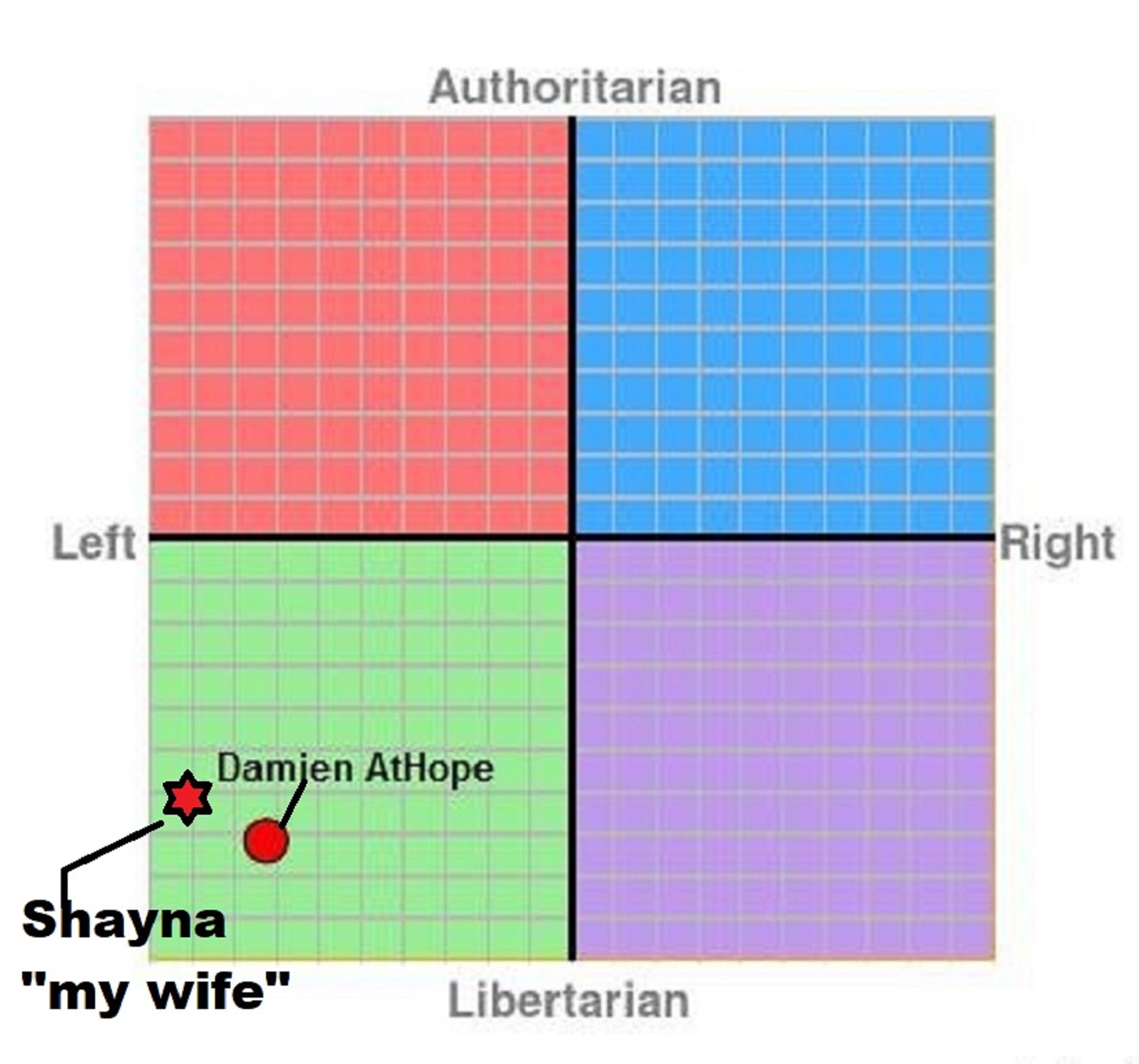
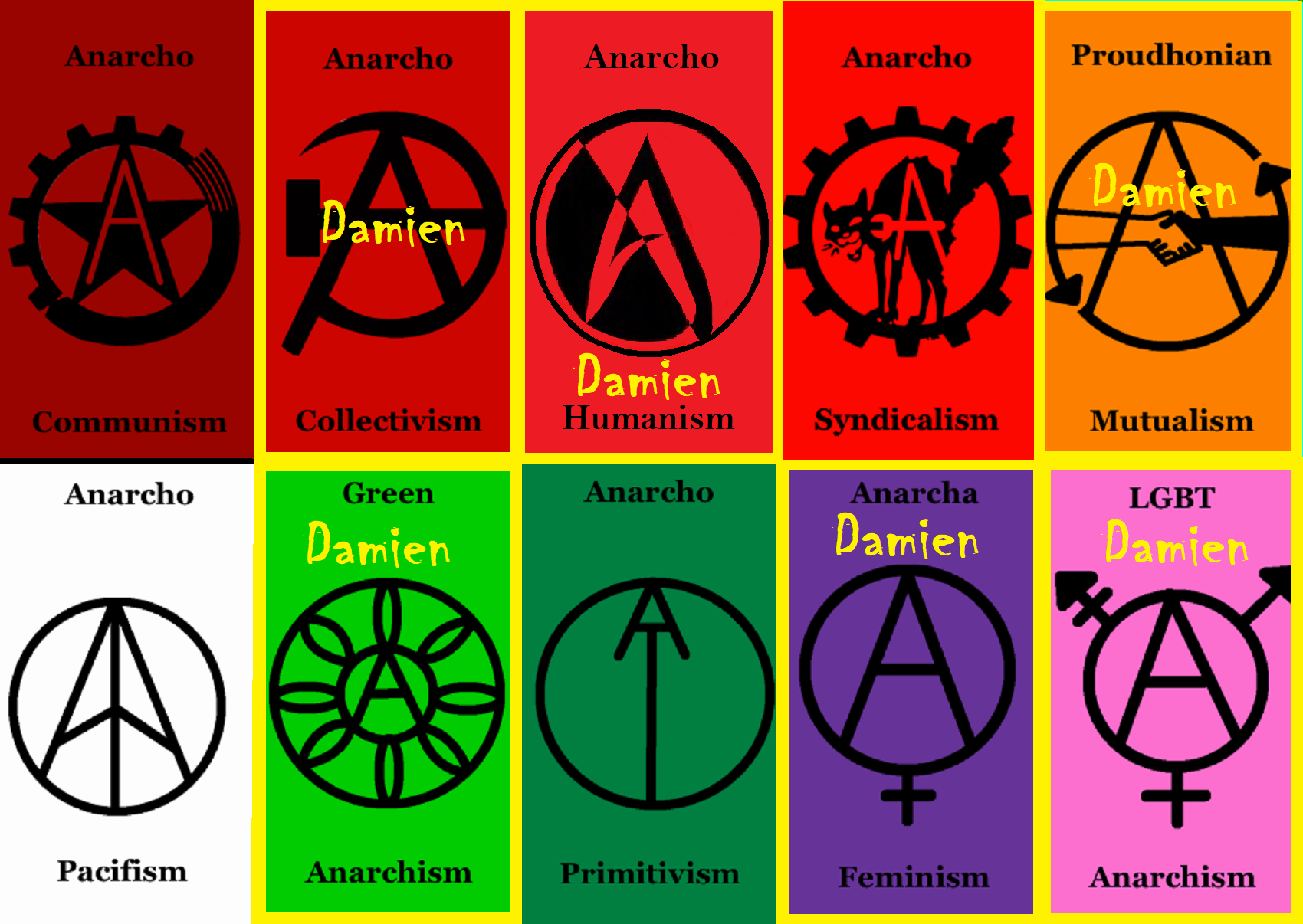
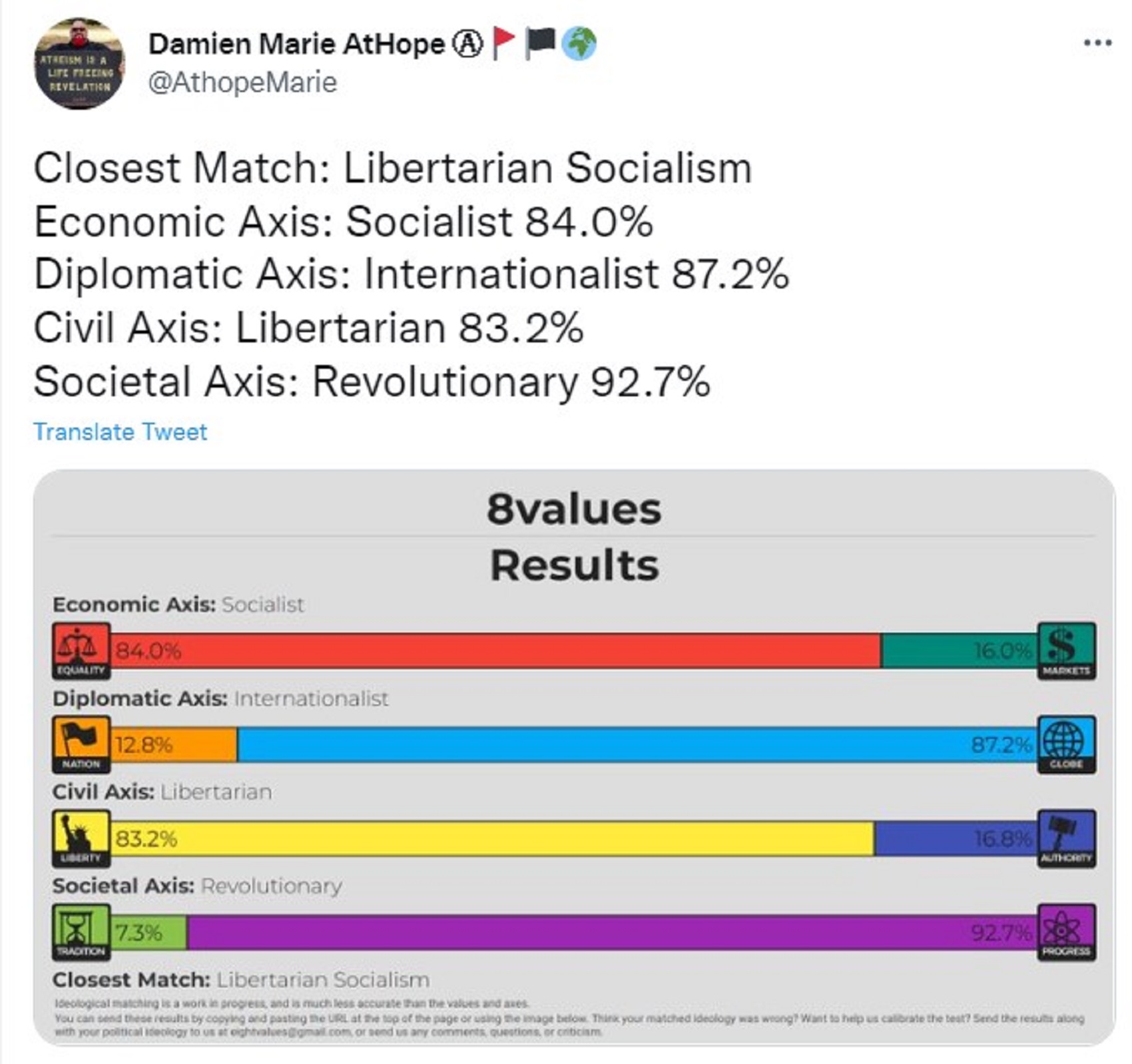


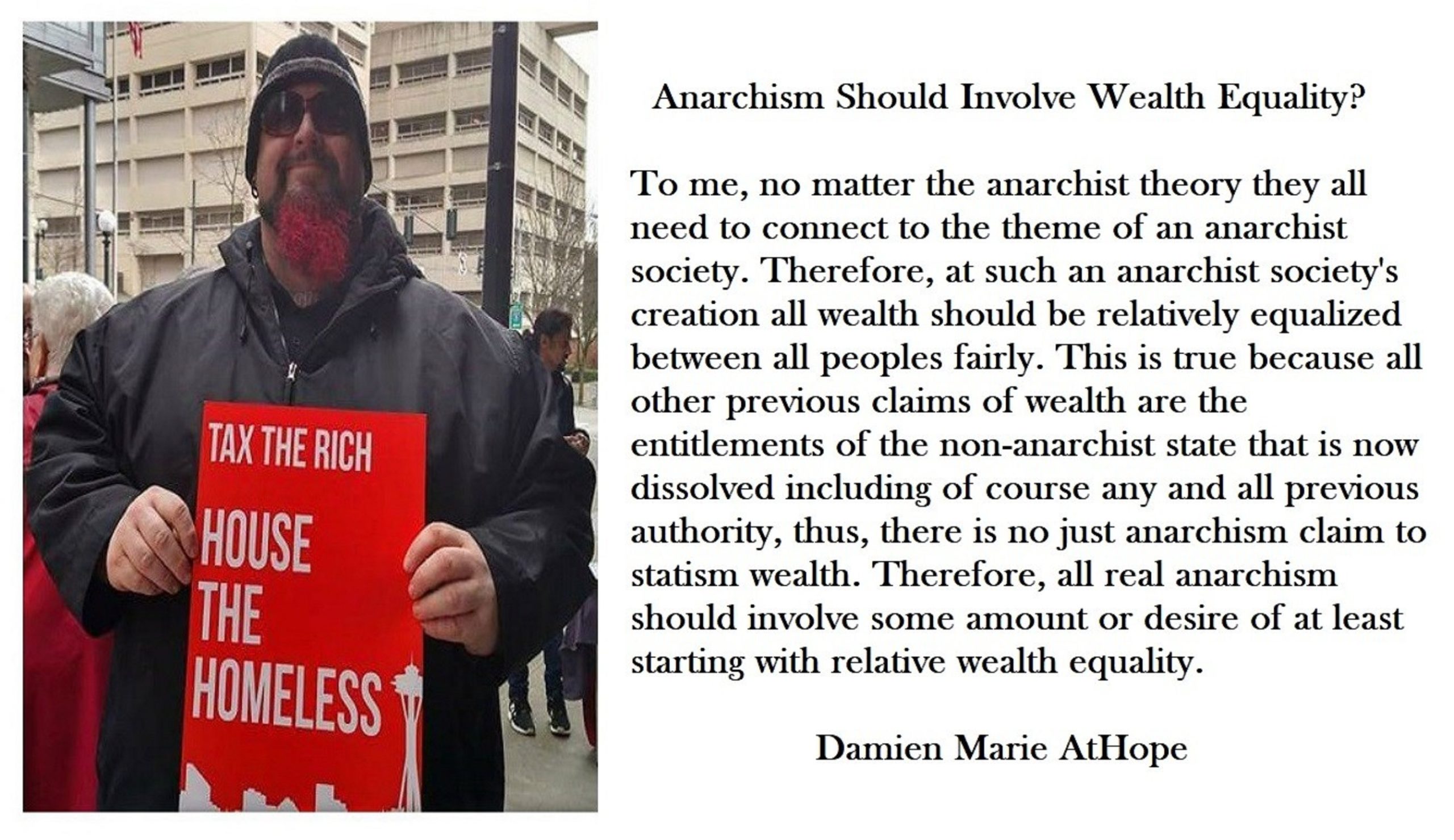


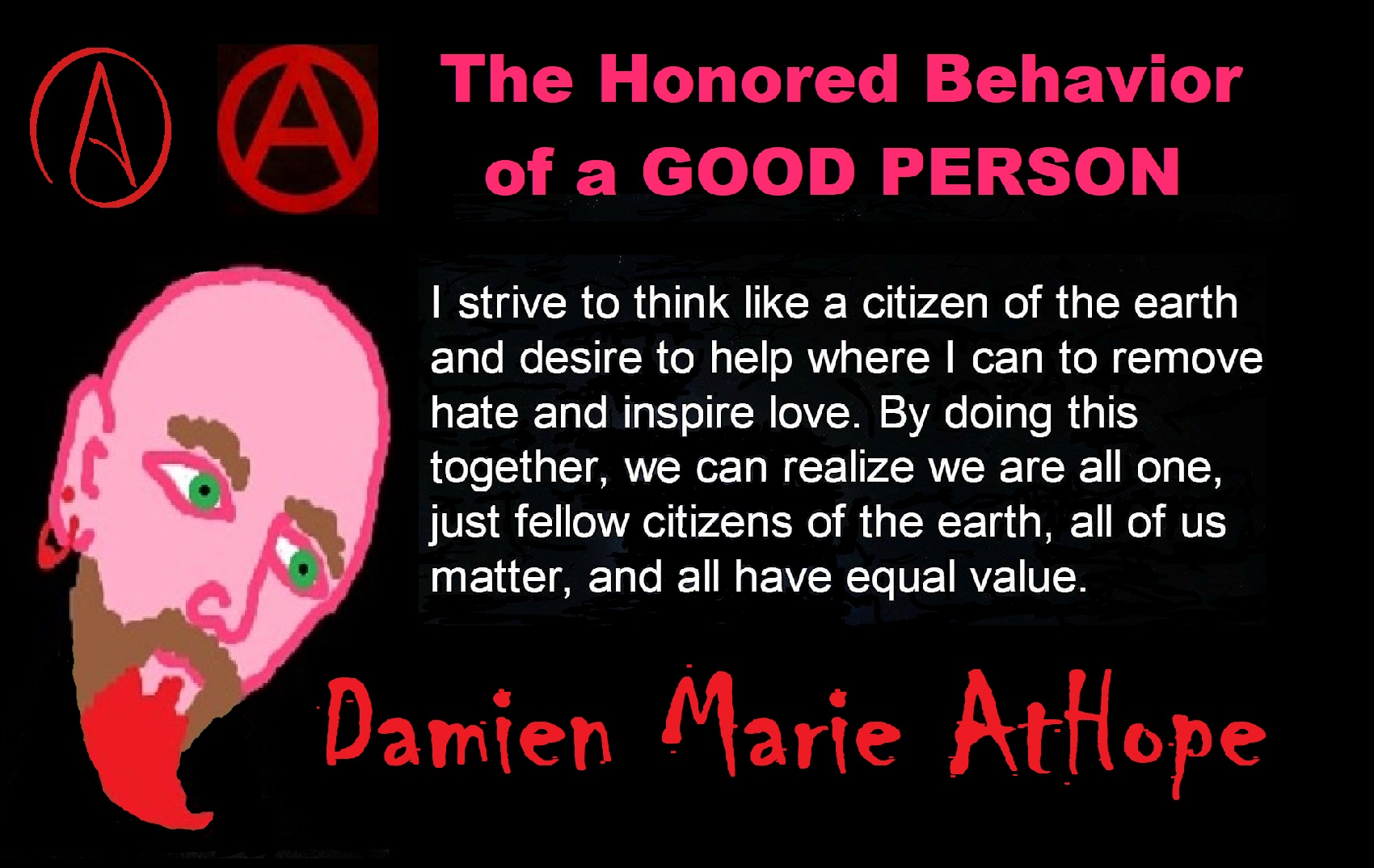
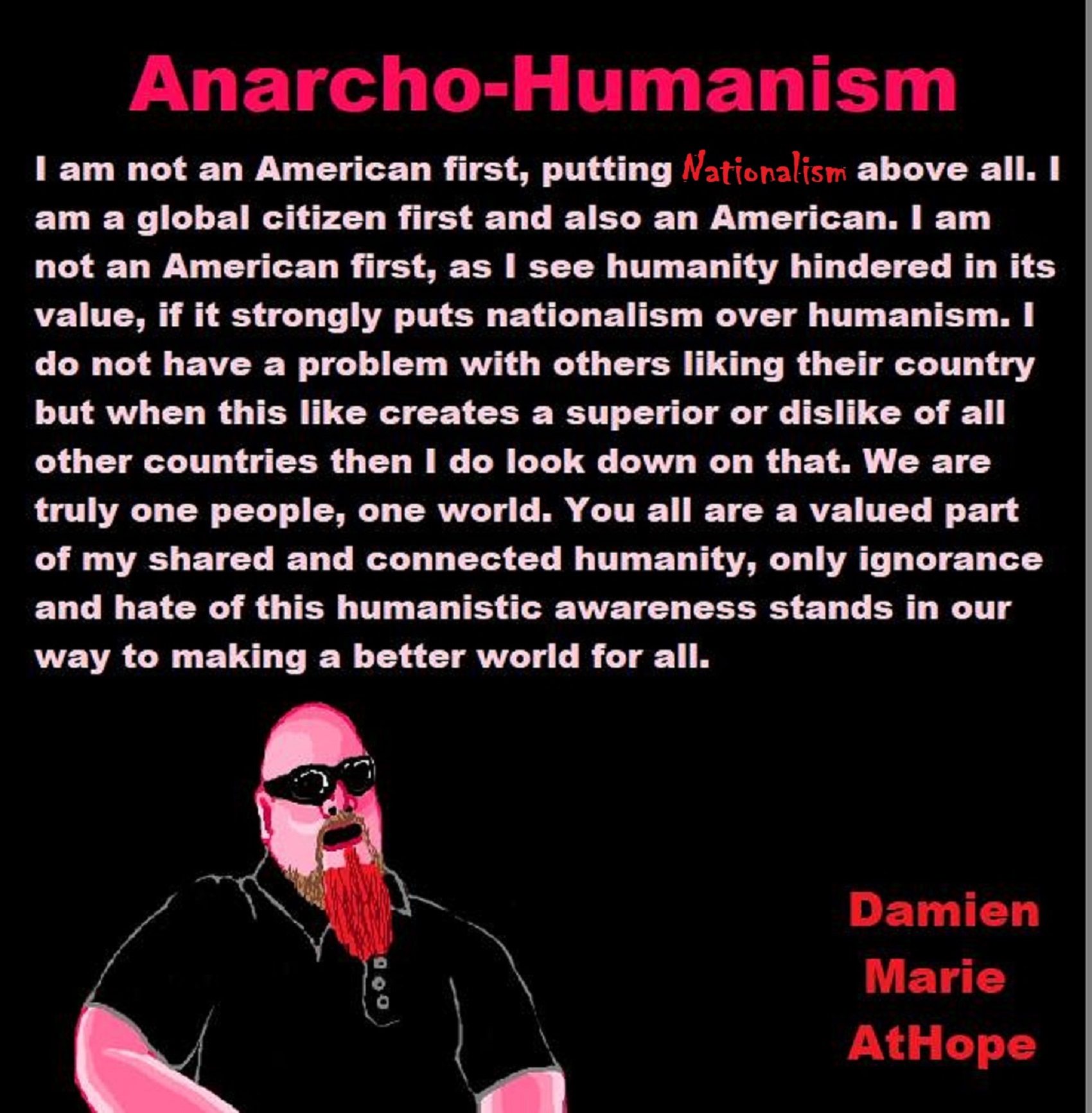
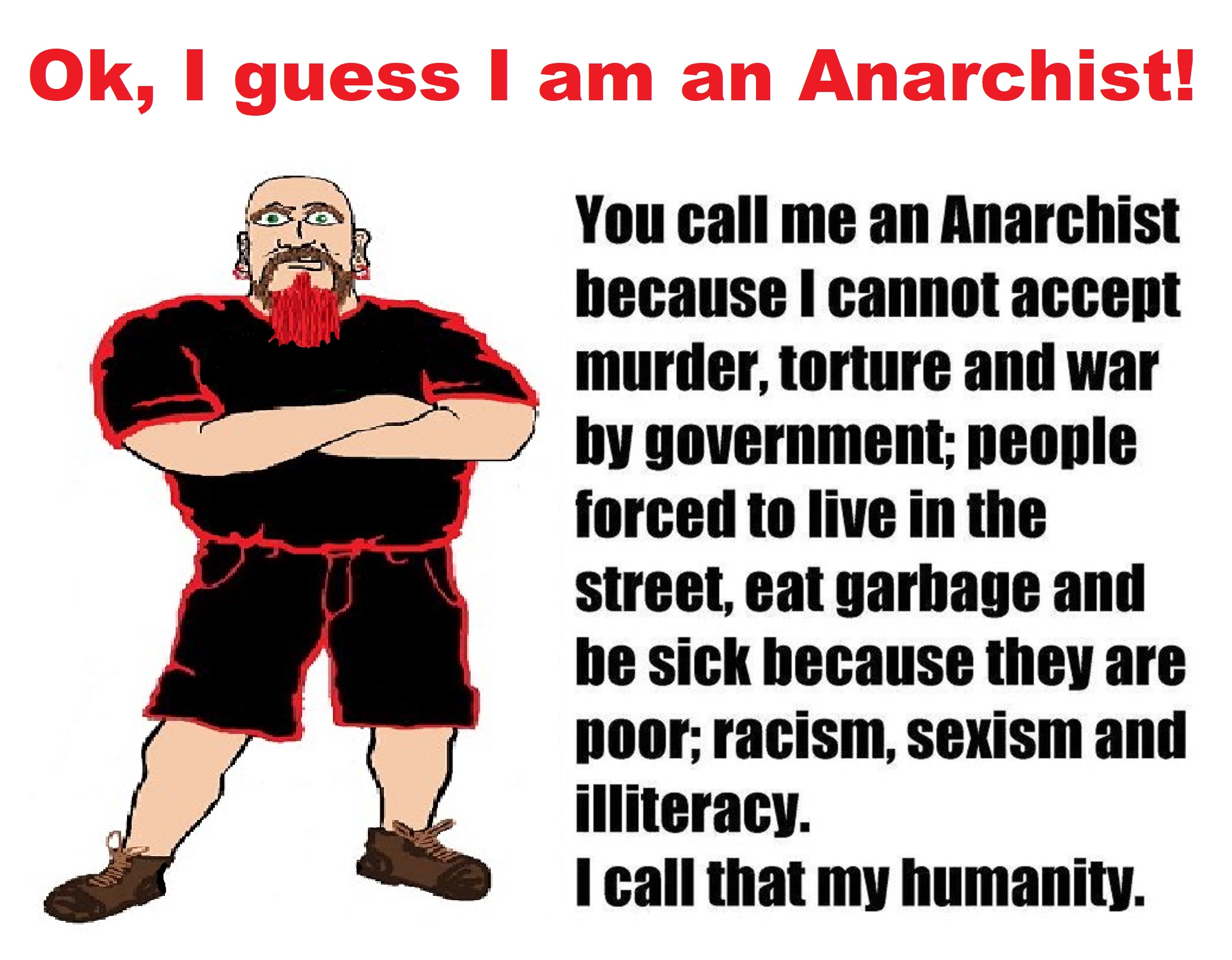
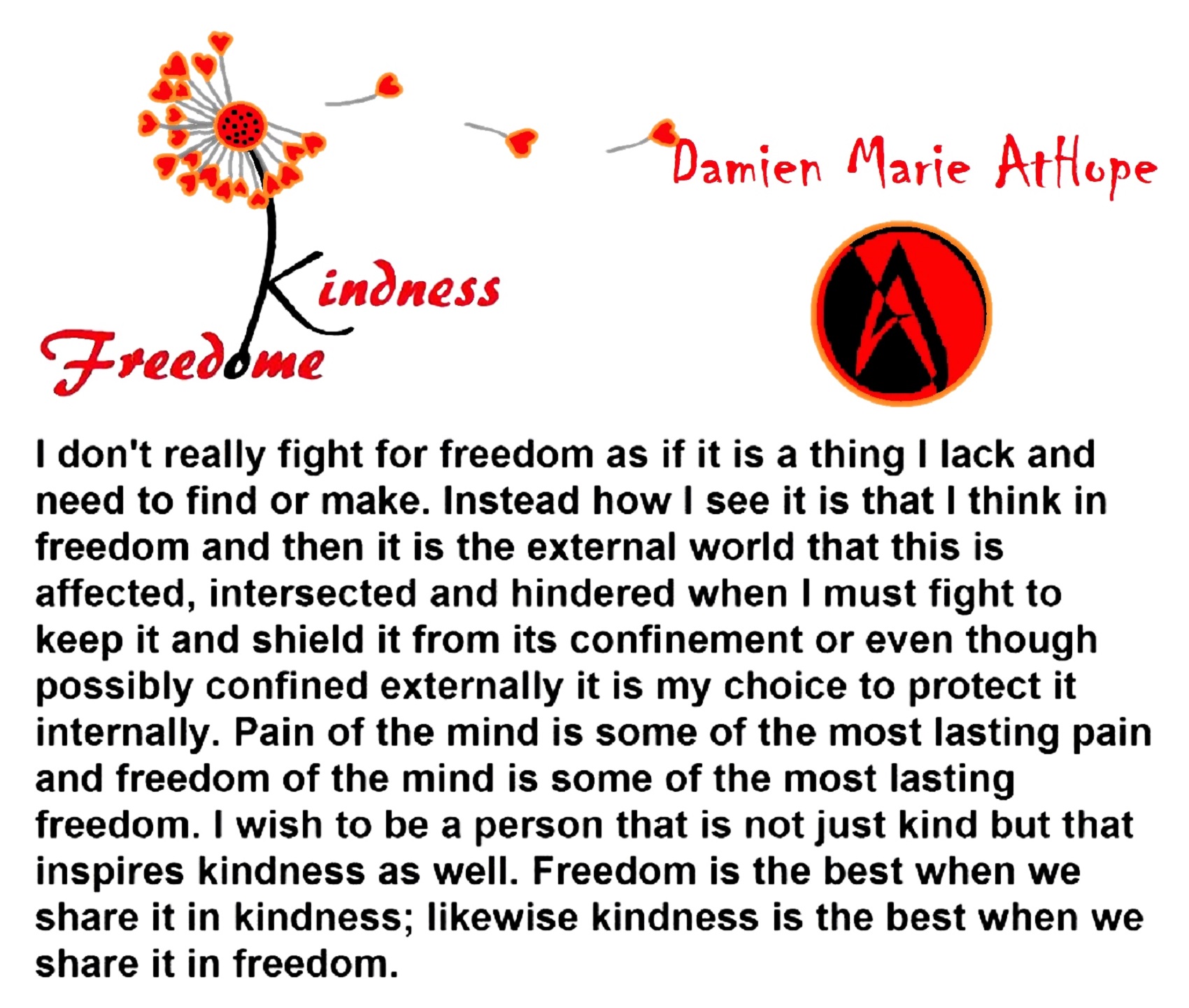
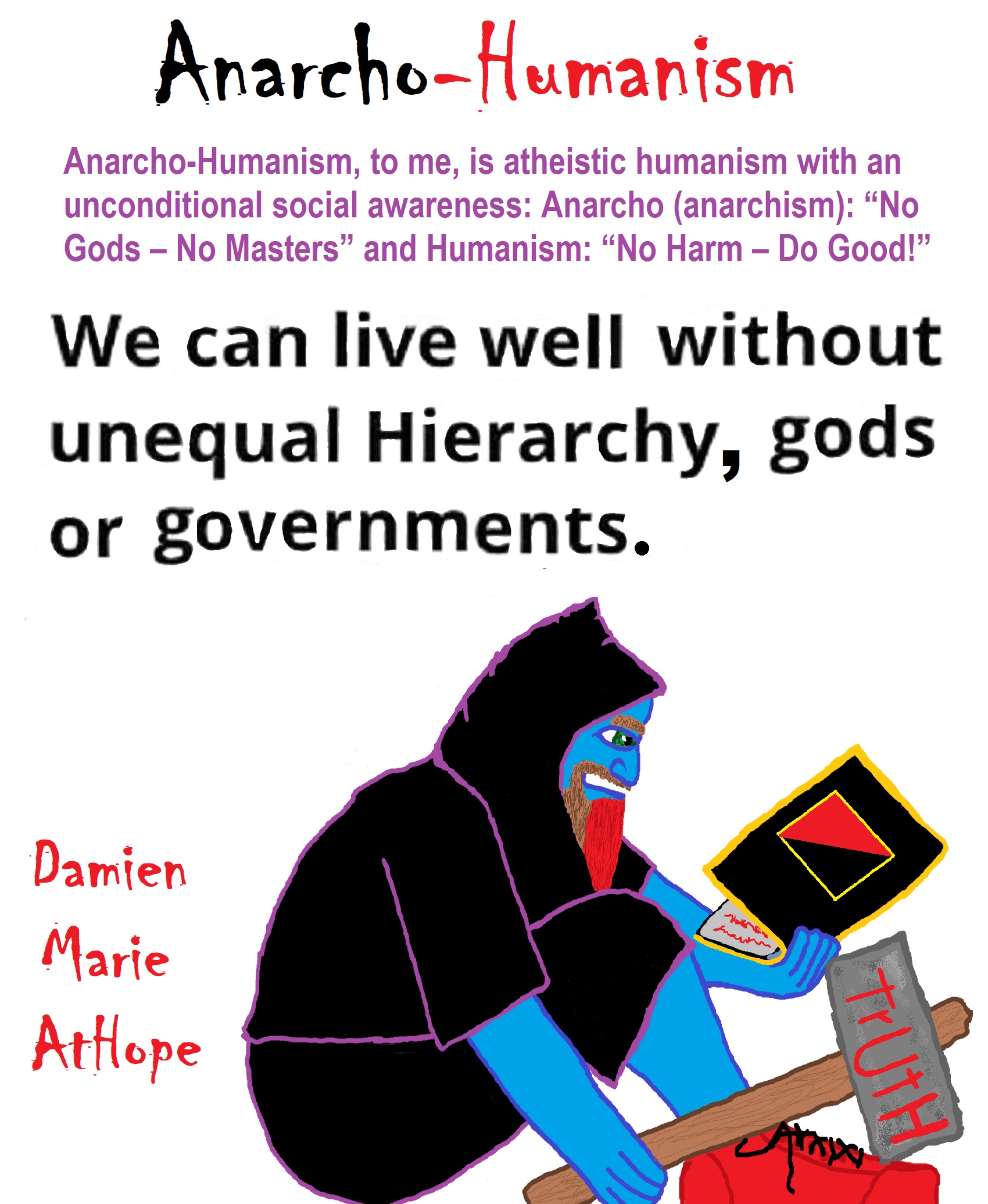

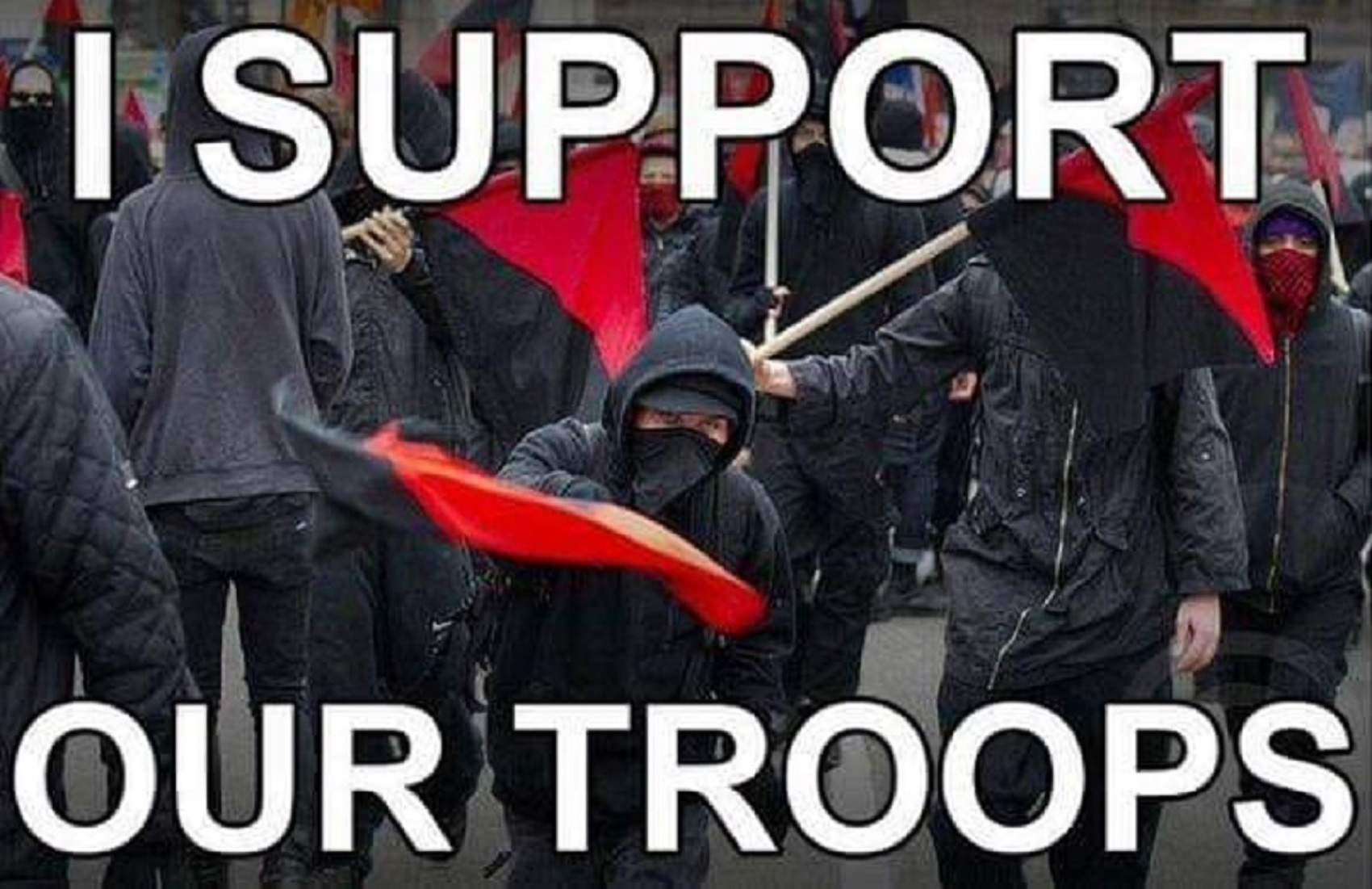
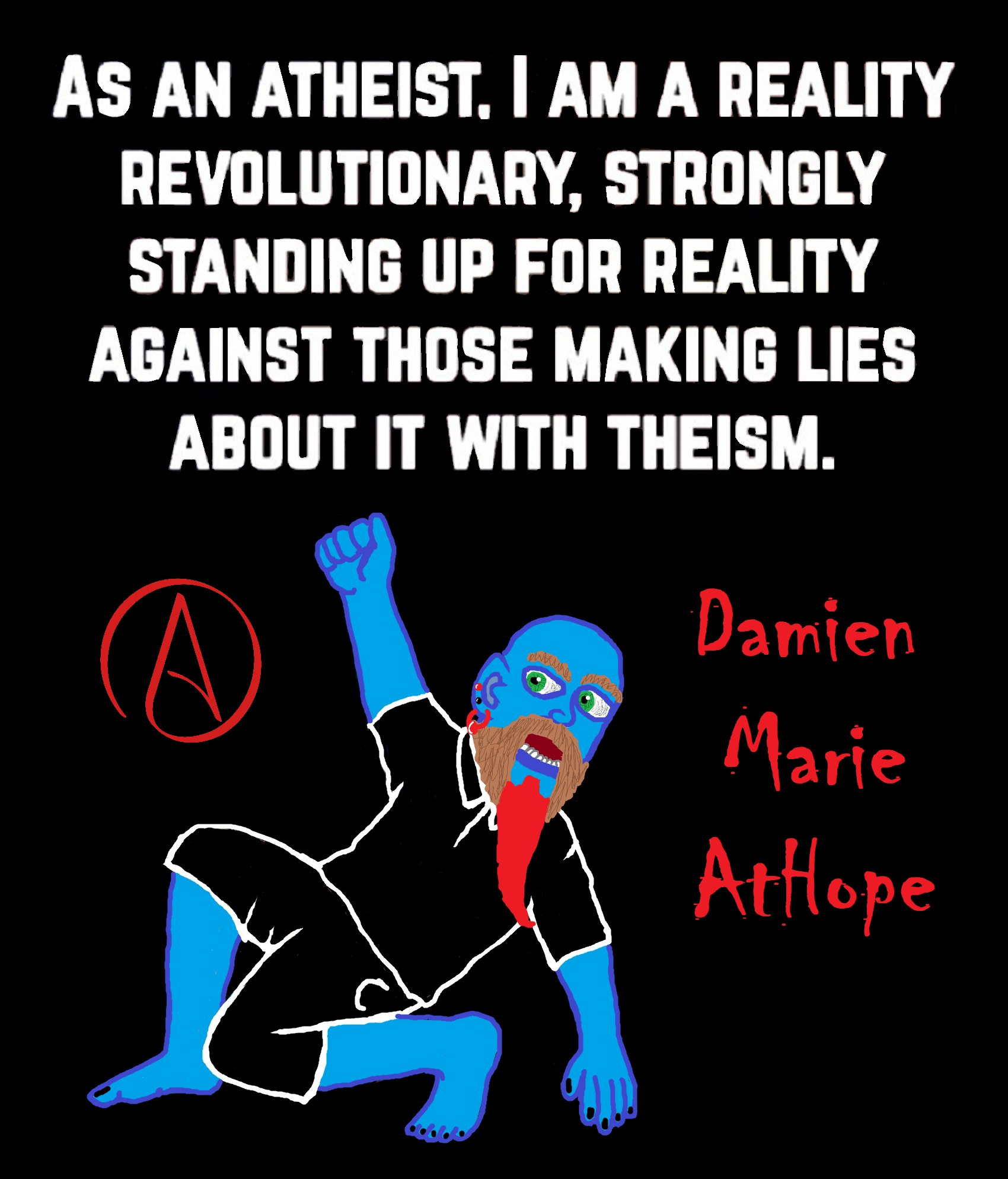


Animism: Respecting the Living World by Graham Harvey
“How have human cultures engaged with and thought about animals, plants, rocks, clouds, and other elements in their natural surroundings? Do animals and other natural objects have a spirit or soul? What is their relationship to humans? In this new study, Graham Harvey explores current and past animistic beliefs and practices of Native Americans, Maori, Aboriginal Australians, and eco-pagans. He considers the varieties of animism found in these cultures as well as their shared desire to live respectfully within larger natural communities. Drawing on his extensive casework, Harvey also considers the linguistic, performative, ecological, and activist implications of these different animisms.” ref


My thoughts on Religion Evolution with external links for more info:
- (Pre-Animism Africa mainly, but also Europe, and Asia at least 300,000 years ago), (Pre-Animism – Oxford Dictionaries)
- (Animism Africa around 100,000 years ago), (Animism – Britannica.com)
- (Totemism Europe around 50,000 years ago), (Totemism – Anthropology)
- (Shamanism Siberia around 30,000 years ago), (Shamanism – Britannica.com)
- (Paganism Turkey around 12,000 years ago), (Paganism – BBC Religion)
- (Progressed Organized Religion “Institutional Religion” Egypt around 5,000 years ago), (Ancient Egyptian Religion – Britannica.com)
- (CURRENT “World” RELIGIONS after 4,000 years ago) (Origin of Major Religions – Sacred Texts)
- (Early Atheistic Doubting at least by 2,600 years ago) (History of Atheism – Wikipedia)
“Religion is an Evolved Product” and Yes, Religion is Like Fear Given Wings…
Atheists talk about gods and religions for the same reason doctors talk about cancer, they are looking for a cure, or a firefighter talks about fires because they burn people and they care to stop them. We atheists too often feel a need to help the victims of mental slavery, held in the bondage that is the false beliefs of gods and the conspiracy theories of reality found in religions.
Understanding Religion Evolution:
- Pre-Animism (at least 300,000 years ago)
- Animism (Africa: 100,000 years ago)
- Totemism (Europe: 50,000 years ago)
- Shamanism (Siberia: 30,000 years ago)
- Paganism (Turkey: 12,000 years ago)
- Progressed organized religion (Egypt: 5,000 years ago), (Egypt, the First Dynasty 5,150 years ago)
- CURRENT “World” RELIGIONS (after 4,000 years ago)
- Early Atheistic Doubting (at least by 2,600 years ago)
“An Archaeological/Anthropological Understanding of Religion Evolution”
It seems ancient peoples had to survived amazing threats in a “dangerous universe (by superstition perceived as good and evil),” and human “immorality or imperfection of the soul” which was thought to affect the still living, leading to ancestor worship. This ancestor worship presumably led to the belief in supernatural beings, and then some of these were turned into the belief in gods. This feeble myth called gods were just a human conceived “made from nothing into something over and over, changing, again and again, taking on more as they evolve, all the while they are thought to be special,” but it is just supernatural animistic spirit-belief perceived as sacred.
Quick Evolution of Religion?
Pre-Animism (at least 300,000 years ago) pre-religion is a beginning that evolves into later Animism. So, Religion as we think of it, to me, all starts in a general way with Animism (Africa: 100,000 years ago) (theoretical belief in supernatural powers/spirits), then this is physically expressed in or with Totemism (Europe: 50,000 years ago) (theoretical belief in mythical relationship with powers/spirits through a totem item), which then enlists a full-time specific person to do this worship and believed interacting Shamanism (Siberia/Russia: 30,000 years ago) (theoretical belief in access and influence with spirits through ritual), and then there is the further employment of myths and gods added to all the above giving you Paganism (Turkey: 12,000 years ago) (often a lot more nature-based than most current top world religions, thus hinting to their close link to more ancient religious thinking it stems from). My hypothesis is expressed with an explanation of the building of a theatrical house (modern religions development). Progressed organized religion (Egypt: 5,000 years ago) with CURRENT “World” RELIGIONS (after 4,000 years ago).
Historically, in large city-state societies (such as Egypt or Iraq) starting around 5,000 years ago culminated to make religion something kind of new, a sociocultural-governmental-religious monarchy, where all or at least many of the people of such large city-state societies seem familiar with and committed to the existence of “religion” as the integrated life identity package of control dynamics with a fixed closed magical doctrine, but this juggernaut integrated religion identity package of Dogmatic-Propaganda certainly did not exist or if developed to an extent it was highly limited in most smaller prehistoric societies as they seem to lack most of the strong control dynamics with a fixed closed magical doctrine (magical beliefs could be at times be added or removed). Many people just want to see developed religious dynamics everywhere even if it is not. Instead, all that is found is largely fragments until the domestication of religion.
Religions, as we think of them today, are a new fad, even if they go back to around 6,000 years in the timeline of human existence, this amounts to almost nothing when seen in the long slow evolution of religion at least around 70,000 years ago with one of the oldest ritual worship. Stone Snake of South Africa: “first human worship” 70,000 years ago. This message of how religion and gods among them are clearly a man-made thing that was developed slowly as it was invented and then implemented peace by peace discrediting them all. Which seems to be a simple point some are just not grasping how devastating to any claims of truth when we can see the lie clearly in the archeological sites.
I wish people fought as hard for the actual values as they fight for the group/clan names political or otherwise they think support values. Every amount spent on war is theft to children in need of food or the homeless kept from shelter.
Here are several of my blog posts on history:
- To Find Truth You Must First Look
- (Magdalenian/Iberomaurusian) Connections to the First Paganists of the early Neolithic Near East Dating from around 17,000 to 12,000 Years Ago
- Natufians: an Ancient People at the Origins of Agriculture and Sedentary Life
- Possible Clan Leader/Special “MALE” Ancestor Totem Poles At Least 13,500 years ago?
- Jewish People with DNA at least 13,200 years old, Judaism, and the Origins of Some of its Ideas
- Baltic Reindeer Hunters: Swiderian, Lyngby, Ahrensburgian, and Krasnosillya cultures 12,020 to 11,020 years ago are evidence of powerful migratory waves during the last 13,000 years and a genetic link to Saami and the Finno-Ugric peoples.
- The Rise of Inequality: patriarchy and state hierarchy inequality
- Fertile Crescent 12,500 – 9,500 Years Ago: fertility and death cult belief system?
- 12,400 – 11,700 Years Ago – Kortik Tepe (Turkey) Pre/early-Agriculture Cultic Ritualism
- Ritualistic Bird Symbolism at Gobekli Tepe and its “Ancestor Cult”
- Male-Homosexual (female-like) / Trans-woman (female) Seated Figurine from Gobekli Tepe
- Could a 12,000-year-old Bull Geoglyph at Göbekli Tepe relate to older Bull and Female Art 25,000 years ago and Later Goddess and the Bull cults like Catal Huyuk?
- Sedentism and the Creation of goddesses around 12,000 years ago as well as male gods after 7,000 years ago.
- Alcohol, where Agriculture and Religion Become one? Such as Gobekli Tepe’s Ritualistic use of Grain as Food and Ritual Drink
- Neolithic Ritual Sites with T-Pillars and other Cultic Pillars
- Paganism: Goddesses around 12,000 years ago then Male Gods after 7,000 years ago
- First Patriarchy: Split of Women’s Status around 12,000 years ago & First Hierarchy: fall of Women’s Status around 5,000 years ago.
- Natufians: an Ancient People at the Origins of Agriculture and Sedentary Life
- J DNA and the Spread of Agricultural Religion (paganism)
- Paganism: an approximately 12,000-year-old belief system
- Paganism 12,000 years old: related to “Anarchism and Socialism” (Pre-Capitalism)
- Shaman burial in Israel 12,000 years ago and the Shamanism Phenomena
- Need to Mythicized: gods and goddesses
- 12,000 – 7,000 Years Ago – Paleo-Indian Culture (The Americas)
- 12,000 – 2,000 Years Ago – Indigenous-Scandinavians (Nordic)
- Norse did not wear helmets with horns?
- Pre-Pottery Neolithic Skull Cult around 11,500 to 8,400 Years Ago?
- 10,400 – 10,100 Years Ago, in Turkey the Nevail Cori Religious Settlement
- 9,000-6,500 Years Old Submerged Pre-Pottery/Pottery Neolithic Ritual Settlements off Israel’s Coast
- Catal Huyuk “first religious designed city” around 9,500 to 7,700 years ago (Turkey)
- Cultic Hunting at Catal Huyuk “first religious designed city”
- Special Items and Art as well as Special Elite Burials at Catal Huyuk
- New Rituals and Violence with the appearance of Pottery and People?
- Haplogroup N and its related Uralic Languages and Cultures
- Ainu people, Sámi people, Native Americans, the Ancient North Eurasians, and Paganistic-Shamanism with Totemism
- Ideas, Technology and People from Turkey, Europe, to China and Back again 9,000 to 5,000 years ago?
- First Pottery of Europe and the Related Cultures
- 9,000 years old Neolithic Artifacts Judean Desert and Hills Israel
- 9,000-7,000 years-old Sex and Death Rituals: Cult Sites in Israel, Jordan, and the Sinai
- 9,000-8500 year old Horned Female shaman Bad Dürrenberg Germany
- Neolithic Jewelry and the Spread of Farming in Europe Emerging out of West Turkey
- 8,600-year-old Tortoise Shells in Neolithic graves in central China have Early Writing and Shamanism
- Swing of the Mace: the rise of Elite, Forced Authority, and Inequality begin to Emerge 8,500 years ago?
- Migrations and Changing Europeans Beginning around 8,000 Years Ago
- My “Steppe-Anatolian-Kurgan hypothesis” 8,000/7,000 years ago
- Around 8,000-year-old Shared Idea of the Mistress of Animals, “Ritual” Motif
- Pre-Columbian Red-Paint (red ochre) Maritime Archaic Culture 8,000-3,000 years ago
- 7,522-6,522 years ago Linear Pottery culture which I think relates to Arcane Capitalism’s origins
- Arcane Capitalism: Primitive socialism, Primitive capital, Private ownership, Means of production, Market capitalism, Class discrimination, and Petite bourgeoisie (smaller capitalists)
- 7,500-4,750 years old Ritualistic Cucuteni-Trypillian culture of Moldova, Romania, and Ukraine
- Roots of a changing early society 7,200-6,700 years ago Jordan and Israel
- Agriculture religion (Paganism) with farming reached Britain between about 7,000 to 6,500 or so years ago and seemingly expressed in things like Western Europe’s Long Barrows
- My Thoughts on Possible Migrations of “R” DNA and Proto-Indo-European?
- “Millet” Spreading from China 7,022 years ago to Europe and related Language may have Spread with it leading to Proto-Indo-European
- Proto-Indo-European (PIE), ancestor of Indo-European languages: DNA, Society, Language, and Mythology
- The Dnieper–Donets culture and Asian varieties of Millet from China to the Black Sea region of Europe by 7,022 years ago
- Kurgan 6,000 years ago/dolmens 7,000 years ago: funeral, ritual, and other?
- 7,020 to 6,020-year-old Proto-Indo-European Homeland of Urheimat or proposed home of their Language and Religion
- Ancient Megaliths: Kurgan, Ziggurat, Pyramid, Menhir, Trilithon, Dolman, Kromlech, and Kromlech of Trilithons
- The Mytheme of Ancient North Eurasian Sacred-Dog belief and similar motifs are found in Indo-European, Native American, and Siberian comparative mythology
- Elite Power Accumulation: Ancient Trade, Tokens, Writing, Wealth, Merchants, and Priest-Kings
- Sacred Mounds, Mountains, Kurgans, and Pyramids may hold deep connections?
- Between 7,000-5,000 Years ago, rise of unequal hierarchy elite, leading to a “birth of the State” or worship of power, strong new sexism, oppression of non-elites, and the fall of Women’s equal status
- Paganism 7,000-5,000 years old: related to “Anarchism and Socialism” (Capitalism) (World War 0) Elite & their slaves
- Hell and Underworld mythologies starting maybe as far back as 7,000 to 5,000 years ago with the Proto-Indo-Europeans?
- The First Expression of the Male God around 7,000 years ago?
- White (light complexion skin) Bigotry and Sexism started 7,000 years ago?
- Around 7,000-year-old Shared Idea of the Divine Bird (Tutelary and/or Trickster spirit/deity), “Ritual” Motif
- Nekhbet an Ancient Egyptian Vulture Goddess and Tutelary Deity
- 6,720 to 4,920 years old Ritualistic Hongshan Culture of Inner Mongolia with 5,000-year-old Pyramid Mounds and Temples
- First proto-king in the Balkans, Varna culture around 6,500 years ago?
- 6,500–5,800 years ago in Israel Late Chalcolithic (Copper Age) Period in the Southern Levant Seems to Express Northern Levant Migrations, Cultural and Religious Transfer
- KING OF BEASTS: Master of Animals “Ritual” Motif, around 6,000 years old or older…
- Around 6000-year-old Shared Idea of the Solid Wheel & the Spoked Wheel-Shaped Ritual Motif
- “The Ghassulian Star,” a mysterious 6,000-year-old mural from Jordan; a Proto-Star of Ishtar, Star of Inanna or Star of Venus?
- Religious/Ritual Ideas, including goddesses and gods as well as ritual mounds or pyramids from Northeastern Asia at least 6,000 years old, seemingly filtering to Iran, Iraq, the Mediterranean, Europe, Egypt, and the Americas?
- Maykop (5,720–5,020 years ago) Caucasus region Bronze Age culture-related to Copper Age farmers from the south, influenced by the Ubaid period and Leyla-Tepe culture, as well as influencing the Kura-Araxes culture
- 5-600-year-old Tomb, Mummy, and First Bearded Male Figurine in a Grave
- Kura-Araxes Cultural 5,520 to 4,470 years old DNA traces to the Canaanites, Arabs, and Jews
- Minoan/Cretan (Keftiu) Civilization and Religion around 5,520 to 3,120 years ago
- Evolution Of Science at least by 5,500 years ago
- 5,500 Years old birth of the State, the rise of Hierarchy, and the fall of Women’s status
- “Jiroft culture” 5,100 – 4,200 years ago and the History of Iran
- Stonehenge: Paganistic Burial and Astrological Ritual Complex, England (5,100-3,600 years ago)
- Around 5,000-year-old Shared Idea of the “Tree of Life” Ritual Motif
- Complex rituals for elite, seen from China to Egypt, at least by 5,000 years ago
- Around 5,000 years ago: “Birth of the State” where Religion gets Military Power and Influence
- The Center of the World “Axis Mundi” and/or “Sacred Mountains” Mythology Could Relate to the Altai Mountains, Heart of the Steppe
- Progressed organized religion starts, an approximately 5,000-year-old belief system
- China’s Civilization between 5,000-3,000 years ago, was a time of war and class struggle, violent transition from free clans to a Slave or Elite society
- Origin of Logics is Naturalistic Observation at least by around 5,000 years ago.
- Paganism 5,000 years old: progressed organized religion and the state: related to “Anarchism and Socialism” (Kings and the Rise of the State)
- Ziggurats (multi-platform temples: 4,900 years old) to Pyramids (multi-platform tombs: 4,700 years old)
- Did a 4,520–4,420-year-old Volcano In Turkey Inspire the Bible God?
- Finland’s Horned Shaman and Pre-Horned-God at least 4,500 years ago?
- 4,000-year-Old Dolmens in Israel: A Connected Dolmen Religious Phenomenon?
- Creation myths: From chaos, Ex nihilo, Earth-diver, Emergence, World egg, and World parent
- Bronze Age “Ritual” connections of the Bell Beaker culture with the Corded Ware/Single Grave culture, which were related to the Yamnaya culture and Proto-Indo-European Languages/Religions
- Low Gods (Earth/ Tutelary deity), High Gods (Sky/Supreme deity), and Moralistic Gods (Deity enforcement/divine order)
- The exchange of people, ideas, and material-culture including, to me, the new god (Sky Father) and goddess (Earth Mother) religion between the Cucuteni-Trypillians and others which is then spread far and wide
- Koryaks: Indigenous People of the Russian Far East and Big Raven myths also found in Tlingit, Haida, Tsimshian, and other Indigenous People of North America
- 42 Principles Of Maat (Egyptian Goddess of the justice) around 4,400 years ago, 2000 Years Before Ten Commandments
- “Happy Easter” Well Happy Eostre/Ishter
- 4,320-3,820 years old “Shimao” (North China) site with Totemistic-Shamanistic Paganism and a Stepped Pyramid
- 4,250 to 3,400 Year old Stonehenge from Russia: Arkaim?
- 4,100-year-old beaker with medicinal & flowering plants in a grave of a woman in Scotland
- Early European Farmer ancestry, Kelif el Boroud people with the Cardial Ware culture, and the Bell Beaker culture Paganists too, spread into North Africa, then to the Canary Islands off West Africa
- Flood Accounts: Gilgamesh epic (4,100 years ago) Noah in Genesis (2,600 years ago)
- Paganism 4,000 years old: related to “Anarchism and Socialism” (First Moralistic gods, then the Origin time of Monotheism)
- When was the beginning: TIMELINE OF CURRENT RELIGIONS, which start around 4,000 years ago.
- Early Religions Thought to Express Proto-Monotheistic Systems around 4,000 years ago
- Kultepe? An archaeological site with a 4,000 years old women’s rights document.
- Single God Religions (Monotheism) = “Man-o-theism” started around 4,000 years ago with the Great Sky Spirit/God Tiān (天)?
- Confucianism’s Tiān (Shangdi god 4,000 years old): Supernaturalism, Pantheism or Theism?
- Yes, Your Male God is Ridiculous
- Mythology, a Lunar Deity is a Goddess or God of the Moon
- Sacred Land, Hills, and Mountains: Sami Mythology (Paganistic Shamanism)
- Horse Worship/Sacrifice: mythical union of Ruling Elite/Kingship and the Horse
- The Amorite/Amurru people’s God Amurru “Lord of the Steppe”, relates to the Origins of the Bible God?
- Bronze Age Exotic Trade Routes Spread Quite Far as well as Spread Religious Ideas with Them
- Sami and the Northern Indigenous Peoples Landscape, Language, and its Connection to Religion
- Prototype of Ancient Analemmatic Sundials around 3,900-3,150 years ago and a Possible Solar Connection to gods?
- Judaism is around 3,450 or 3,250 years old. (“Paleo-Hebrew” 3,000 years ago and Torah 2,500 years ago)
- The Weakening of Ancient Trade and the Strengthening of Religions around 3000 years ago?
- Are you aware that there are religions that worship women gods, explain now religion tears women down?
- Animistic, Totemistic, and Paganistic Superstition Origins of bible god and the bible’s Religion.
- Myths and Folklore: “Trickster gods and goddesses”
- Jews, Judaism, and the Origins of Some of its Ideas
- An Old Branch of Religion Still Giving Fruit: Sacred Trees
- Dating the BIBLE: naming names and telling times (written less than 3,000 years ago, provable to 2,200 years ago)
- Did a Volcano Inspire the bible god?
- Dené–Yeniseian language, Old Copper Complex, and Pre-Columbian Mound Builders?
- No “dinosaurs and humans didn’t exist together just because some think they are in the bible itself”
- Sacred Shit and Sacred Animals?
- Everyone Killed in the Bible Flood? “Nephilim” (giants)?
- Hey, Damien dude, I have a question for you regarding “the bible” Exodus.
- Archaeology Disproves the Bible
- Bible Battle, Just More, Bible Babble
- The Jericho Conquest lie?
- Canaanites and Israelites?
- Accurate Account on how did Christianity Began?
- Let’s talk about Christianity.
- So the 10 commandments isn’t anything to go by either right?
- Misinformed christian
- Debunking Jesus?
- Paulism vs Jesus
- Ok, you seem confused so let’s talk about Buddhism.
- Unacknowledged Buddhism: Gods, Savior, Demons, Rebirth, Heavens, Hells, and Terrorism
- His Foolishness The Dalai Lama
- Yin and Yang is sexist with an ORIGIN around 2,300 years ago?
- I Believe Archaeology, not Myths & Why Not, as the Religious Myths Already Violate Reason!
- Archaeological, Scientific, & Philosophic evidence shows the god myth is man-made nonsense.
- Aquatic Ape Theory/Hypothesis? As Always, Just Pseudoscience.
- Ancient Aliens Conspiracy Theorists are Pseudohistorians
- The Pseudohistoric and Pseudoscientific claims about “Bakoni Ruins” of South Africa
- Why do people think Religion is much more than supernaturalism and superstitionism?
- Religion is an Evolved Product
- Was the Value of Ancient Women Different?
- 1000 to 1100 CE, human sacrifice Cahokia Mounds a pre-Columbian Native American site
- Feminist atheists as far back as the 1800s?
- Promoting Religion as Real is Mentally Harmful to a Flourishing Humanity
- Screw All Religions and Their Toxic lies, they are all fraud
- Forget Religions’ Unfounded Myths, I Have Substantiated “Archaeology Facts.”
- Religion Dispersal throughout the World
- I Hate Religion Just as I Hate all Pseudoscience
- Exposing Scientology, Eckankar, Wicca and Other Nonsense?
- Main deity or religious belief systems
- Quit Trying to Invent Your God From the Scraps of Science.
- Archaeological, Scientific, & Philosophic evidence shows the god myth is man-made nonsense.
- Ancient Alien Conspiracy Theorists: Misunderstanding, Rhetoric, Misinformation, Fabrications, and Lies
- Misinformation, Distortion, and Pseudoscience in Talking with a Christian Creationist
- Judging the Lack of Goodness in Gods, Even the Norse God Odin
- Challenging the Belief in God-like Aliens and Gods in General
- A Challenge to Christian use of Torture Devices?
- Yes, Hinduism is a Religion
- Trump is One of the Most Reactionary Forces of Far-right Christian Extremism
- Was the Bull Head a Symbol of God? Yes!
- Primate Death Rituals
- Christian – “God and Christianity are objectively true”
- Australopithecus afarensis Death Ritual?
- You Claim Global Warming is a Hoax?
- Doubter of Science and Defamer of Atheists?
- I think that sounds like the Bible?
- History of the Antifa (“anti-fascist”) Movements
- Indianapolis Anti-Blasphemy Laws #Free Soheil Rally
- Damien, you repeat the golden rule in so many forms then you say religion is dogmatic?
- Science is a Trustable Methodology whereas Faith is not Trustable at all!
- Was I ever a believer, before I was an atheist?
- Atheists rise in reason
- Mistrust of science?
- Open to Talking About the Definition of ‘God’? But first, we address Faith.
- ‘United Monarchy’ full of splendor and power – Saul, David, and Solomon? Most likely not.
- Is there EXODUS ARCHAEOLOGY? The short answer is “no.”
- Lacking Proof of Bigfoots, Unicorns, and Gods is Just a Lack of Research?
- Religion and Politics: Faith Beliefs vs. Rational Thinking
- Hammer of Truth that lying pig RELIGION: challenged by an archaeologist
- “The Hammer of Truth” -ontology question- What do You Mean by That?
- Navigation of a bad argument: Ad Hominem vs. Attack
- Why is it Often Claimed that Gods have a Gender?
- Why are basically all monotheistic religions ones that have a male god?
- Shifting through the Claims in support of Faith
- Dear Mr. AtHope, The 20th Century is an Indictment of Secularism and a Failed Atheist Century
- An Understanding of the Worldwide Statistics and Dynamics of Terrorist Incidents and Suicide Attacks
- Intoxication and Evolution? Addressing and Assessing the “Stoned Ape” or “Drunken Monkey” Theories as Catalysts in Human Evolution
- Sacred Menstrual cloth? Inanna’s knot, Isis knot, and maybe Ma’at’s feather?
- Damien, why don’t the Hebrews accept the bible stories?
- Dealing with a Troll and Arguing Over Word Meaning
- Knowledge without Belief? Justified beliefs or disbeliefs worthy of Knowledge?
- Afrocentrism and African Religions
- Crecganford @crecganford offers history & stories of the people, places, gods, & culture
- Empiricism-Denier?
I am not an academic. I am a revolutionary that teaches in public, in places like social media, and in the streets. I am not a leader by some title given but from my commanding leadership style of simply to start teaching everywhere to everyone, all manner of positive education.









ref, ref, ref, ref, ref, ref, ref, ref, ref, ref, ref, ref, ref, ref, ref, ref, ref, ref, ref, ref, ref
Low Gods “Earth” or Tutelary deity and High Gods “Sky” or Supreme deity
“An Earth goddess is a deification of the Earth. Earth goddesses are often associated with the “chthonic” deities of the underworld. Ki and Ninhursag are Mesopotamian earth goddesses. In Greek mythology, the Earth is personified as Gaia, corresponding to Roman Terra, Indic Prithvi/Bhūmi, etc. traced to an “Earth Mother” complementary to the “Sky Father” in Proto-Indo-European religion. Egyptian mythology exceptionally has a sky goddess and an Earth god.” ref
“A mother goddess is a goddess who represents or is a personification of nature, motherhood, fertility, creation, destruction or who embodies the bounty of the Earth. When equated with the Earth or the natural world, such goddesses are sometimes referred to as Mother Earth or as the Earth Mother. In some religious traditions or movements, Heavenly Mother (also referred to as Mother in Heaven or Sky Mother) is the wife or feminine counterpart of the Sky father or God the Father.” ref
“Any masculine sky god is often also king of the gods, taking the position of patriarch within a pantheon. Such king gods are collectively categorized as “sky father” deities, with a polarity between sky and earth often being expressed by pairing a “sky father” god with an “earth mother” goddess (pairings of a sky mother with an earth father are less frequent). A main sky goddess is often the queen of the gods and may be an air/sky goddess in her own right, though she usually has other functions as well with “sky” not being her main. In antiquity, several sky goddesses in ancient Egypt, Mesopotamia, and the Near East were called Queen of Heaven. Neopagans often apply it with impunity to sky goddesses from other regions who were never associated with the term historically. The sky often has important religious significance. Many religions, both polytheistic and monotheistic, have deities associated with the sky.” ref
“In comparative mythology, sky father is a term for a recurring concept in polytheistic religions of a sky god who is addressed as a “father”, often the father of a pantheon and is often either a reigning or former King of the Gods. The concept of “sky father” may also be taken to include Sun gods with similar characteristics, such as Ra. The concept is complementary to an “earth mother“. “Sky Father” is a direct translation of the Vedic Dyaus Pita, etymologically descended from the same Proto-Indo-European deity name as the Greek Zeûs Pater and Roman Jupiter and Germanic Týr, Tir or Tiwaz, all of which are reflexes of the same Proto-Indo-European deity’s name, *Dyēus Ph₂tḗr. While there are numerous parallels adduced from outside of Indo-European mythology, there are exceptions (e.g. In Egyptian mythology, Nut is the sky mother and Geb is the earth father).” ref
Tutelary deity
“A tutelary (also tutelar) is a deity or spirit who is a guardian, patron, or protector of a particular place, geographic feature, person, lineage, nation, culture, or occupation. The etymology of “tutelary” expresses the concept of safety and thus of guardianship. In late Greek and Roman religion, one type of tutelary deity, the genius, functions as the personal deity or daimon of an individual from birth to death. Another form of personal tutelary spirit is the familiar spirit of European folklore.” ref
“A tutelary (also tutelar) in Korean shamanism, jangseung and sotdae were placed at the edge of villages to frighten off demons. They were also worshiped as deities. Seonangshin is the patron deity of the village in Korean tradition and was believed to embody the Seonangdang. In Philippine animism, Diwata or Lambana are deities or spirits that inhabit sacred places like mountains and mounds and serve as guardians. Such as: Maria Makiling is the deity who guards Mt. Makiling and Maria Cacao and Maria Sinukuan. In Shinto, the spirits, or kami, which give life to human bodies come from nature and return to it after death. Ancestors are therefore themselves tutelaries to be worshiped. And similarly, Native American beliefs such as Tonás, tutelary animal spirit among the Zapotec and Totems, familial or clan spirits among the Ojibwe, can be animals.” ref
“A tutelary (also tutelar) in Austronesian beliefs such as: Atua (gods and spirits of the Polynesian peoples such as the Māori or the Hawaiians), Hanitu (Bunun of Taiwan‘s term for spirit), Hyang (Kawi, Sundanese, Javanese, and Balinese Supreme Being, in ancient Java and Bali mythology and this spiritual entity, can be either divine or ancestral), Kaitiaki (New Zealand Māori term used for the concept of guardianship, for the sky, the sea, and the land), Kawas (mythology) (divided into 6 groups: gods, ancestors, souls of the living, spirits of living things, spirits of lifeless objects, and ghosts), Tiki (Māori mythology, Tiki is the first man created by either Tūmatauenga or Tāne and represents deified ancestors found in most Polynesian cultures). ” ref, ref, ref, ref, ref, ref, ref
Mesopotamian Tutelary Deities can be seen as ones related to City-States
“Historical city-states included Sumerian cities such as Uruk and Ur; Ancient Egyptian city-states, such as Thebes and Memphis; the Phoenician cities (such as Tyre and Sidon); the five Philistine city-states; the Berber city-states of the Garamantes; the city-states of ancient Greece (the poleis such as Athens, Sparta, Thebes, and Corinth); the Roman Republic (which grew from a city-state into a vast empire); the Italian city-states from the Middle Ages to the early modern period, such as Florence, Siena, Ferrara, Milan (which as they grew in power began to dominate neighboring cities) and Genoa and Venice, which became powerful thalassocracies; the Mayan and other cultures of pre-Columbian Mesoamerica (including cities such as Chichen Itza, Tikal, Copán and Monte Albán); the central Asian cities along the Silk Road; the city-states of the Swahili coast; Ragusa; states of the medieval Russian lands such as Novgorod and Pskov; and many others.” ref
“The Uruk period (ca. 4000 to 3100 BCE; also known as Protoliterate period) of Mesopotamia, named after the Sumerian city of Uruk, this period saw the emergence of urban life in Mesopotamia and the Sumerian civilization. City-States like Uruk and others had a patron tutelary City Deity along with a Priest-King.” ref
“Chinese folk religion, both past, and present, includes myriad tutelary deities. Exceptional individuals, highly cultivated sages, and prominent ancestors can be deified and honored after death. Lord Guan is the patron of military personnel and police, while Mazu is the patron of fishermen and sailors. Such as Tu Di Gong (Earth Deity) is the tutelary deity of a locality, and each individual locality has its own Earth Deity and Cheng Huang Gong (City God) is the guardian deity of an individual city, worshipped by local officials and locals since imperial times.” ref
“A tutelary (also tutelar) in Hinduism, personal tutelary deities are known as ishta-devata, while family tutelary deities are known as Kuladevata. Gramadevata are guardian deities of villages. Devas can also be seen as tutelary. Shiva is the patron of yogis and renunciants. City goddesses include: Mumbadevi (Mumbai), Sachchika (Osian); Kuladevis include: Ambika (Porwad), and Mahalakshmi. In NorthEast India Meitei mythology and religion (Sanamahism) of Manipur, there are various types of tutelary deities, among which Lam Lais are the most predominant ones. Tibetan Buddhism has Yidam as a tutelary deity. Dakini is the patron of those who seek knowledge.” ref
“A tutelary (also tutelar) The Greeks also thought deities guarded specific places: for instance, Athena was the patron goddess of the city of Athens. Socrates spoke of hearing the voice of his personal spirit or daimonion:
You have often heard me speak of an oracle or sign which comes to me … . This sign I have had ever since I was a child. The sign is a voice which comes to me and always forbids me to do something which I am going to do, but never commands me to do anything, and this is what stands in the way of my being a politician.” ref
“Tutelary deities who guard and preserve a place or a person are fundamental to ancient Roman religion. The tutelary deity of a man was his Genius, that of a woman her Juno. In the Imperial era, the Genius of the Emperor was a focus of Imperial cult. An emperor might also adopt a major deity as his personal patron or tutelary, as Augustus did Apollo. Precedents for claiming the personal protection of a deity were established in the Republican era, when for instance the Roman dictator Sulla advertised the goddess Victory as his tutelary by holding public games (ludi) in her honor.” ref
“Each town or city had one or more tutelary deities, whose protection was considered particularly vital in time of war and siege. Rome itself was protected by a goddess whose name was to be kept ritually secret on pain of death (for a supposed case, see Quintus Valerius Soranus). The Capitoline Triad of Juno, Jupiter, and Minerva were also tutelaries of Rome. The Italic towns had their own tutelary deities. Juno often had this function, as at the Latin town of Lanuvium and the Etruscan city of Veii, and was often housed in an especially grand temple on the arx (citadel) or other prominent or central location. The tutelary deity of Praeneste was Fortuna, whose oracle was renowned.” ref
“The Roman ritual of evocatio was premised on the belief that a town could be made vulnerable to military defeat if the power of its tutelary deity were diverted outside the city, perhaps by the offer of superior cult at Rome. The depiction of some goddesses such as the Magna Mater (Great Mother, or Cybele) as “tower-crowned” represents their capacity to preserve the city. A town in the provinces might adopt a deity from within the Roman religious sphere to serve as its guardian, or syncretize its own tutelary with such; for instance, a community within the civitas of the Remi in Gaul adopted Apollo as its tutelary, and at the capital of the Remi (present-day Rheims), the tutelary was Mars Camulus.” ref
Household deity (a kind of or related to a Tutelary deity)
“A household deity is a deity or spirit that protects the home, looking after the entire household or certain key members. It has been a common belief in paganism as well as in folklore across many parts of the world. Household deities fit into two types; firstly, a specific deity – typically a goddess – often referred to as a hearth goddess or domestic goddess who is associated with the home and hearth, such as the ancient Greek Hestia.” ref
“The second type of household deities are those that are not one singular deity, but a type, or species of animistic deity, who usually have lesser powers than major deities. This type was common in the religions of antiquity, such as the Lares of ancient Roman religion, the Gashin of Korean shamanism, and Cofgodas of Anglo-Saxon paganism. These survived Christianisation as fairy-like creatures existing in folklore, such as the Anglo-Scottish Brownie and Slavic Domovoy.” ref
“Household deities were usually worshipped not in temples but in the home, where they would be represented by small idols (such as the teraphim of the Bible, often translated as “household gods” in Genesis 31:19 for example), amulets, paintings, or reliefs. They could also be found on domestic objects, such as cosmetic articles in the case of Tawaret. The more prosperous houses might have a small shrine to the household god(s); the lararium served this purpose in the case of the Romans. The gods would be treated as members of the family and invited to join in meals, or be given offerings of food and drink.” ref
“In many religions, both ancient and modern, a god would preside over the home. Certain species, or types, of household deities, existed. An example of this was the Roman Lares. Many European cultures retained house spirits into the modern period. Some examples of these include:
- Brownie (Scotland and England) or Hob (England) / Kobold (Germany) / Goblin / Hobgoblin
- Domovoy (Slavic)
- Nisse (Norwegian or Danish) / Tomte (Swedish) / Tonttu (Finnish)
- Húsvættir (Norse)” ref
“Although the cosmic status of household deities was not as lofty as that of the Twelve Olympians or the Aesir, they were also jealous of their dignity and also had to be appeased with shrines and offerings, however humble. Because of their immediacy they had arguably more influence on the day-to-day affairs of men than the remote gods did. Vestiges of their worship persisted long after Christianity and other major religions extirpated nearly every trace of the major pagan pantheons. Elements of the practice can be seen even today, with Christian accretions, where statues to various saints (such as St. Francis) protect gardens and grottos. Even the gargoyles found on older churches, could be viewed as guardians partitioning a sacred space.” ref
“For centuries, Christianity fought a mop-up war against these lingering minor pagan deities, but they proved tenacious. For example, Martin Luther‘s Tischreden have numerous – quite serious – references to dealing with kobolds. Eventually, rationalism and the Industrial Revolution threatened to erase most of these minor deities, until the advent of romantic nationalism rehabilitated them and embellished them into objects of literary curiosity in the 19th century. Since the 20th century this literature has been mined for characters for role-playing games, video games, and other fantasy personae, not infrequently invested with invented traits and hierarchies somewhat different from their mythological and folkloric roots.” ref
“In contradistinction to both Herbert Spencer and Edward Burnett Tylor, who defended theories of animistic origins of ancestor worship, Émile Durkheim saw its origin in totemism. In reality, this distinction is somewhat academic, since totemism may be regarded as a particularized manifestation of animism, and something of a synthesis of the two positions was attempted by Sigmund Freud. In Freud’s Totem and Taboo, both totem and taboo are outward expressions or manifestations of the same psychological tendency, a concept which is complementary to, or which rather reconciles, the apparent conflict. Freud preferred to emphasize the psychoanalytic implications of the reification of metaphysical forces, but with particular emphasis on its familial nature. This emphasis underscores, rather than weakens, the ancestral component.” ref
“William Edward Hearn, a noted classicist, and jurist, traced the origin of domestic deities from the earliest stages as an expression of animism, a belief system thought to have existed also in the neolithic, and the forerunner of Indo-European religion. In his analysis of the Indo-European household, in Chapter II “The House Spirit”, Section 1, he states:
The belief which guided the conduct of our forefathers was … the spirit rule of dead ancestors.” ref
“In Section 2 he proceeds to elaborate:
It is thus certain that the worship of deceased ancestors is a vera causa, and not a mere hypothesis. …
In the other European nations, the Slavs, the Teutons, and the Kelts, the House Spirit appears with no less distinctness. … [T]he existence of that worship does not admit of doubt. … The House Spirits had a multitude of other names which it is needless here to enumerate, but all of which are more or less expressive of their friendly relations with man. … In [England] … [h]e is the Brownie. … In Scotland this same Brownie is well known. He is usually described as attached to particular families, with whom he has been known to reside for centuries, threshing the corn, cleaning the house, and performing similar household tasks. His favorite gratification was milk and honey.” ref

Hinduism around 3,700 to 3,500 years old. ref
Judaism around 3,450 or 3,250 years old. (The first writing in the bible was “Paleo-Hebrew” dated to around 3,000 years ago Khirbet Qeiyafa is the site of an ancient fortress city overlooking the Elah Valley. And many believe the religious Jewish texts were completed around 2,500) ref, ref
Judaism is around 3,450 or 3,250 years old. (“Paleo-Hebrew” 3,000 years ago and Torah 2,500 years ago)
“Judaism is an Abrahamic, its roots as an organized religion in the Middle East during the Bronze Age. Some scholars argue that modern Judaism evolved from Yahwism, the religion of ancient Israel and Judah, by the late 6th century BCE, and is thus considered to be one of the oldest monotheistic religions.” ref
“Yahwism is the name given by modern scholars to the religion of ancient Israel, essentially polytheistic, with a plethora of gods and goddesses. Heading the pantheon was Yahweh, the national god of the Israelite kingdoms of Israel and Judah, with his consort, the goddess Asherah; below them were second-tier gods and goddesses such as Baal, Shamash, Yarikh, Mot, and Astarte, all of whom had their own priests and prophets and numbered royalty among their devotees, and a third and fourth tier of minor divine beings, including the mal’ak, the messengers of the higher gods, who in later times became the angels of Judaism, Christianity and Islam. Yahweh, however, was not the ‘original’ god of Israel “Isra-El”; it is El, the head of the Canaanite pantheon, whose name forms the basis of the name “Israel”, and none of the Old Testament patriarchs, the tribes of Israel, the Judges, or the earliest monarchs, have a Yahwistic theophoric name (i.e., one incorporating the name of Yahweh).” ref
“El is a Northwest Semitic word meaning “god” or “deity“, or referring (as a proper name) to any one of multiple major ancient Near Eastern deities. A rarer form, ‘ila, represents the predicate form in Old Akkadian and in Amorite. The word is derived from the Proto-Semitic *ʔil-, meaning “god”. Specific deities known as ‘El or ‘Il include the supreme god of the ancient Canaanite religion and the supreme god of East Semitic speakers in Mesopotamia’s Early Dynastic Period. ʼĒl is listed at the head of many pantheons. In some Canaanite and Ugaritic sources, ʼĒl played a role as father of the gods, of creation, or both. For example, in the Ugaritic texts, ʾil mlk is understood to mean “ʼĒl the King” but ʾil hd as “the god Hadad“. The Semitic root ʾlh (Arabic ʾilāh, Aramaic ʾAlāh, ʾElāh, Hebrew ʾelōah) may be ʾl with a parasitic h, and ʾl may be an abbreviated form of ʾlh. In Ugaritic the plural form meaning “gods” is ʾilhm, equivalent to Hebrew ʾelōhîm “powers”. In the Hebrew texts this word is interpreted as being semantically singular for “god” by biblical commentators. However the documentary hypothesis for the Old Testament (corresponds to the Jewish Torah) developed originally in the 1870s, identifies these that different authors – the Jahwist, Elohist, Deuteronomist, and the Priestly source – were responsible for editing stories from a polytheistic religion into those of a monotheistic religion. Inconsistencies that arise between monotheism and polytheism in the texts are reflective of this hypothesis.” ref
Jainism around 2,599 – 2,527 years old. ref
Confucianism around 2,600 – 2,551 years old. ref
Buddhism around 2,563/2,480 – 2,483/2,400 years old. ref
Christianity around 2,o00 years old. ref
Shinto around 1,305 years old. ref
Islam around 1407–1385 years old. ref

Knowledge to Ponder:
Stars/Astrology:
- Possibly, around 30,000 years ago (in simpler form) to 6,000 years ago, Stars/Astrology are connected to Ancestors, Spirit Animals, and Deities.
- The star also seems to be a possible proto-star for Star of Ishtar, Star of Inanna, or Star of Venus.
- Around 7,000 to 6,000 years ago, Star Constellations/Astrology have connections to the “Kurgan phenomenon” of below-ground “mound” stone/wood burial structures and “Dolmen phenomenon” of above-ground stone burial structures.
- Around 6,500–5,800 years ago, The Northern Levant migrations into Jordon and Israel in the Southern Levant brought new cultural and religious transfer from Turkey and Iran.
- “The Ghassulian Star,” a mysterious 6,000-year-old mural from Jordan may have connections to the European paganstic kurgan/dolmens phenomenon.
“Astrology is a range of divinatory practices, recognized as pseudoscientific since the 18th century, that claim to discern information about human affairs and terrestrial events by studying the apparent positions of celestial objects. Different cultures have employed forms of astrology since at least the 2nd millennium BCE, these practices having originated in calendrical systems used to predict seasonal shifts and to interpret celestial cycles as signs of divine communications. Most, if not all, cultures have attached importance to what they observed in the sky, and some—such as the Hindus, Chinese, and the Maya—developed elaborate systems for predicting terrestrial events from celestial observations. Western astrology, one of the oldest astrological systems still in use, can trace its roots to 19th–17th century BCE Mesopotamia, from where it spread to Ancient Greece, Rome, the Islamicate world and eventually Central and Western Europe. Contemporary Western astrology is often associated with systems of horoscopes that purport to explain aspects of a person’s personality and predict significant events in their lives based on the positions of celestial objects; the majority of professional astrologers rely on such systems.” ref
Around 5,500 years ago, Science evolves, The first evidence of science was 5,500 years ago and was demonstrated by a body of empirical, theoretical, and practical knowledge about the natural world. ref
Around 5,000 years ago, Origin of Logics is a Naturalistic Observation (principles of valid reasoning, inference, & demonstration) ref
Around 4,150 to 4,000 years ago: The earliest surviving versions of the Sumerian Epic of Gilgamesh, which was originally titled “He who Saw the Deep” (Sha naqba īmuru) or “Surpassing All Other Kings” (Shūtur eli sharrī) were written. ref
Hinduism:
- 3,700 years ago or so, the oldest of the Hindu Vedas (scriptures), the Rig Veda was composed.
- 3,500 years ago or so, the Vedic Age began in India after the collapse of the Indus Valley Civilization.
Judaism:
- around 3,000 years ago, the first writing in the bible was “Paleo-Hebrew”
- around 2,500 years ago, many believe the religious Jewish texts were completed
Myths: The bible inspired religion is not just one religion or one myth but a grouping of several religions and myths
- Around 3,450 or 3,250 years ago, according to legend, is the traditionally accepted period in which the Israelite lawgiver, Moses, provided the Ten Commandments.
- Around 2,500 to 2,400 years ago, a collection of ancient religious writings by the Israelites based primarily upon the Hebrew Bible, Tanakh, or Old Testament is the first part of Christianity’s bible.
- Around 2,400 years ago, the most accepted hypothesis is that the canon was formed in stages, first the Pentateuch (Torah).
- Around 2,140 to 2,116 years ago, the Prophets was written during the Hasmonean dynasty, and finally the remaining books.
- Christians traditionally divide the Old Testament into four sections:
- The first five books or Pentateuch (Torah).
- The proposed history books telling the history of the Israelites from their conquest of Canaan to their defeat and exile in Babylon.
- The poetic and proposed “Wisdom books” dealing, in various forms, with questions of good and evil in the world.
- The books of the biblical prophets, warning of the consequences of turning away from God:
- Henotheism:
- Exodus 20:23 “You shall not make other gods besides Me (not saying there are no other gods just not to worship them); gods of silver or gods of gold, you shall not make for yourselves.”
- Polytheism:
- Judges 10:6 “Then the sons of Israel again did evil in the sight of the LORD, served the Baals and the Ashtaroth, the gods of Aram, the gods of Sidon, the gods of Moab, the gods of the sons of Ammon, and the gods of the Philistines; thus they forsook the LORD and did not serve Him.”
- 1 Corinthians 8:5 “For even if there are so-called gods whether in heaven or on earth, as indeed there are many gods and many lords.”
- Monotheism:
- Isaiah 43:10 “You are my witnesses,” declares the LORD, “and my servant whom I have chosen, so that you may know and believe me and understand that I am he. Before me no god was formed, nor will there be one after me.
Around 2,570 to 2,270 Years Ago, there is a confirmation of atheistic doubting as well as atheistic thinking, mainly by Greek philosophers. However, doubting gods is likely as old as the invention of gods and should destroy the thinking that belief in god(s) is the “default belief”. The Greek word is apistos (a “not” and pistos “faithful,”), thus not faithful or faithless because one is unpersuaded and unconvinced by a god(s) claim. Short Definition: unbelieving, unbeliever, or unbelief.

Expressions of Atheistic Thinking:
- Around 2,600 years ago, Ajita Kesakambali, ancient Indian philosopher, who is the first known proponent of Indian materialism. ref
- Around 2,535 to 2,475 years ago, Heraclitus, Greek pre-Socratic philosopher, a native of the Greek city Ephesus, Ionia, on the coast of Anatolia, also known as Asia Minor or modern Turkey. ref
- Around 2,500 to 2,400 years ago, according to The Story of Civilization book series certain African pygmy tribes have no identifiable gods, spirits, or religious beliefs or rituals, and even what burials accrue are without ceremony. ref
- Around 2,490 to 2,430 years ago, Empedocles, Greek pre-Socratic philosopher and a citizen of Agrigentum, a Greek city in Sicily. ref
- Around 2,460 to 2,370 years ago, Democritus, Greek pre-Socratic philosopher considered to be the “father of modern science” possibly had some disbelief amounting to atheism. ref
- Around 2,399 years ago or so, Socrates, a famous Greek philosopher was tried for sinfulness by teaching doubt of state gods. ref
- Around 2,341 to 2,270 years ago, Epicurus, a Greek philosopher known for composing atheistic critics and famously stated, “Is God willing to prevent evil, but not able? Then he is not omnipotent. Is he able, but not willing? Then he is malevolent. Is he both able and willing? Then whence cometh evil? Is he neither able nor willing? Then why call him god?” ref
This last expression by Epicurus, seems to be an expression of Axiological Atheism. To understand and utilize value or actually possess “Value Conscious/Consciousness” to both give a strong moral “axiological” argument (the problem of evil) as well as use it to fortify humanism and positive ethical persuasion of human helping and care responsibilities. Because value-blindness gives rise to sociopathic/psychopathic evil.



While hallucinogens are associated with shamanism, it is alcohol that is associated with paganism.
The Atheist-Humanist-Leftist Revolutionaries Shows in the prehistory series:
Show two: Pre-animism 300,000 years old and animism 100,000 years old: related to “Anarchism and Socialism”
Show tree: Totemism 50,000 years old: related to “Anarchism and Socialism”
Show four: Shamanism 30,000 years old: related to “Anarchism and Socialism”
Show five: Paganism 12,000 years old: related to “Anarchism and Socialism”
Show six: Emergence of hierarchy, sexism, slavery, and the new male god dominance: Paganism 7,000-5,000 years old: related to “Anarchism and Socialism” (Capitalism) (World War 0) Elite and their slaves!
Prehistory: related to “Anarchism and Socialism” the division of labor, power, rights, and recourses: VIDEO
Pre-animism 300,000 years old and animism 100,000 years old: related to “Anarchism and Socialism”: VIDEO
Totemism 50,000 years old: related to “Anarchism and Socialism”: VIDEO
Shamanism 30,000 years old: related to “Anarchism and Socialism”: VIDEO
Paganism 12,000 years old: related to “Anarchism and Socialism” (Pre-Capitalism): VIDEO
Paganism 7,000-5,000 years old: related to “Anarchism and Socialism” (Capitalism) (World War 0) Elite and their slaves: VIEDO
Paganism 5,000 years old: progressed organized religion and the state: related to “Anarchism and Socialism” (Kings and the Rise of the State): VIEDO
Paganism 4,000 years old: related to “Anarchism and Socialism” (First Moralistic gods, then the Origin time of Monotheism): VIEDO
I do not hate simply because I challenge and expose myths or lies any more than others being thought of as loving simply because of the protection and hiding from challenge their favored myths or lies.
The truth is best championed in the sunlight of challenge.
An archaeologist once said to me “Damien religion and culture are very different”
My response, So are you saying that was always that way, such as would you say Native Americans’ cultures are separate from their religions? And do you think it always was the way you believe?
I had said that religion was a cultural product. That is still how I see it and there are other archaeologists that think close to me as well. Gods too are the myths of cultures that did not understand science or the world around them, seeing magic/supernatural everywhere.
I personally think there is a goddess and not enough evidence to support a male god at Çatalhöyük but if there was both a male and female god and goddess then I know the kind of gods they were like Proto-Indo-European mythology.
This series idea was addressed in, Anarchist Teaching as Free Public Education or Free Education in the Public: VIDEO
Our 12 video series: Organized Oppression: Mesopotamian State Force and the Politics of power (9,000-4,000 years ago), is adapted from: The Complete and Concise History of the Sumerians and Early Bronze Age Mesopotamia (7000-2000 BC): https://www.youtube.com/watch?v=szFjxmY7jQA by “History with Cy“
Show #1: Mesopotamian State Force and the Politics of Power (Samarra, Halaf, Ubaid)
Show #2: Mesopotamian State Force and the Politics of Power
Show #3: Mesopotamian State Force and the Politics of Power (Uruk and the First Cities)
Show #4: Mesopotamian State Force and the Politics of Power (First Kings)
Show #5: Mesopotamian State Force and the Politics of Power (Early Dynastic Period)
Show #6: Mesopotamian State Force and the Politics of Power
Show #7: Mesopotamian State Force and the Politics of Power (Sargon and Akkadian Rule)
Show #9: Mesopotamian State Force and the Politics of Power (Gudea of Lagash and Utu-hegal)
Show #12: Mesopotamian State Force and the Politics of Power (Aftermath and Legacy of Sumer)

The “Atheist-Humanist-Leftist Revolutionaries”
Cory Johnston ☭ Ⓐ Atheist Leftist @Skepticallefty & I (Damien Marie AtHope) @AthopeMarie (my YouTube & related blog) are working jointly in atheist, antitheist, antireligionist, antifascist, anarchist, socialist, and humanist endeavors in our videos together, generally, every other Saturday.
Why Does Power Bring Responsibility?
Think, how often is it the powerless that start wars, oppress others, or commit genocide? So, I guess the question is to us all, to ask, how can power not carry responsibility in a humanity concept? I know I see the deep ethical responsibility that if there is power their must be a humanistic responsibility of ethical and empathic stewardship of that power. Will I be brave enough to be kind? Will I possess enough courage to be compassionate? Will my valor reach its height of empathy? I as everyone, earns our justified respect by our actions, that are good, ethical, just, protecting, and kind. Do I have enough self-respect to put my love for humanity’s flushing, over being brought down by some of its bad actors? May we all be the ones doing good actions in the world, to help human flourishing.
I create the world I want to live in, striving for flourishing. Which is not a place but a positive potential involvement and promotion; a life of humanist goal precision. To master oneself, also means mastering positive prosocial behaviors needed for human flourishing. I may have lost a god myth as an atheist, but I am happy to tell you, my friend, it is exactly because of that, leaving the mental terrorizer, god belief, that I truly regained my connected ethical as well as kind humanity.
Cory and I will talk about prehistory and theism, addressing the relevance to atheism, anarchism, and socialism.
At the same time as the rise of the male god, 7,000 years ago, there was also the very time there was the rise of violence, war, and clans to kingdoms, then empires, then states. It is all connected back to 7,000 years ago, and it moved across the world.
Cory Johnston: https://damienmarieathope.com/2021/04/cory-johnston-mind-of-a-skeptical-leftist/?v=32aec8db952d
The Mind of a Skeptical Leftist (YouTube)
Cory Johnston: Mind of a Skeptical Leftist @Skepticallefty
The Mind of a Skeptical Leftist By Cory Johnston: “Promoting critical thinking, social justice, and left-wing politics by covering current events and talking to a variety of people. Cory Johnston has been thoughtfully talking to people and attempting to promote critical thinking, social justice, and left-wing politics.” http://anchor.fm/skepticalleft
Cory needs our support. We rise by helping each other.
Cory Johnston ☭ Ⓐ @Skepticallefty Evidence-based atheist leftist (he/him) Producer, host, and co-host of 4 podcasts @skeptarchy @skpoliticspod and @AthopeMarie
Damien Marie AtHope (“At Hope”) Axiological Atheist, Anti-theist, Anti-religionist, Secular Humanist. Rationalist, Writer, Artist, Poet, Philosopher, Advocate, Activist, Psychology, and Armchair Archaeology/Anthropology/Historian.
Damien is interested in: Freedom, Liberty, Justice, Equality, Ethics, Humanism, Science, Atheism, Antiteism, Antireligionism, Ignosticism, Left-Libertarianism, Anarchism, Socialism, Mutualism, Axiology, Metaphysics, LGBTQI, Philosophy, Advocacy, Activism, Mental Health, Psychology, Archaeology, Social Work, Sexual Rights, Marriage Rights, Woman’s Rights, Gender Rights, Child Rights, Secular Rights, Race Equality, Ageism/Disability Equality, Etc. And a far-leftist, “Anarcho-Humanist.”
I am not a good fit in the atheist movement that is mostly pro-capitalist, I am anti-capitalist. Mostly pro-skeptic, I am a rationalist not valuing skepticism. Mostly pro-agnostic, I am anti-agnostic. Mostly limited to anti-Abrahamic religions, I am an anti-religionist.
To me, the “male god” seems to have either emerged or become prominent around 7,000 years ago, whereas the now favored monotheism “male god” is more like 4,000 years ago or so. To me, the “female goddess” seems to have either emerged or become prominent around 11,000-10,000 years ago or so, losing the majority of its once prominence around 2,000 years ago due largely to the now favored monotheism “male god” that grow in prominence after 4,000 years ago or so.
My Thought on the Evolution of Gods?
Animal protector deities from old totems/spirit animal beliefs come first to me, 13,000/12,000 years ago, then women as deities 11,000/10,000 years ago, then male gods around 7,000/8,000 years ago. Moralistic gods around 5,000/4,000 years ago, and monotheistic gods around 4,000/3,000 years ago.

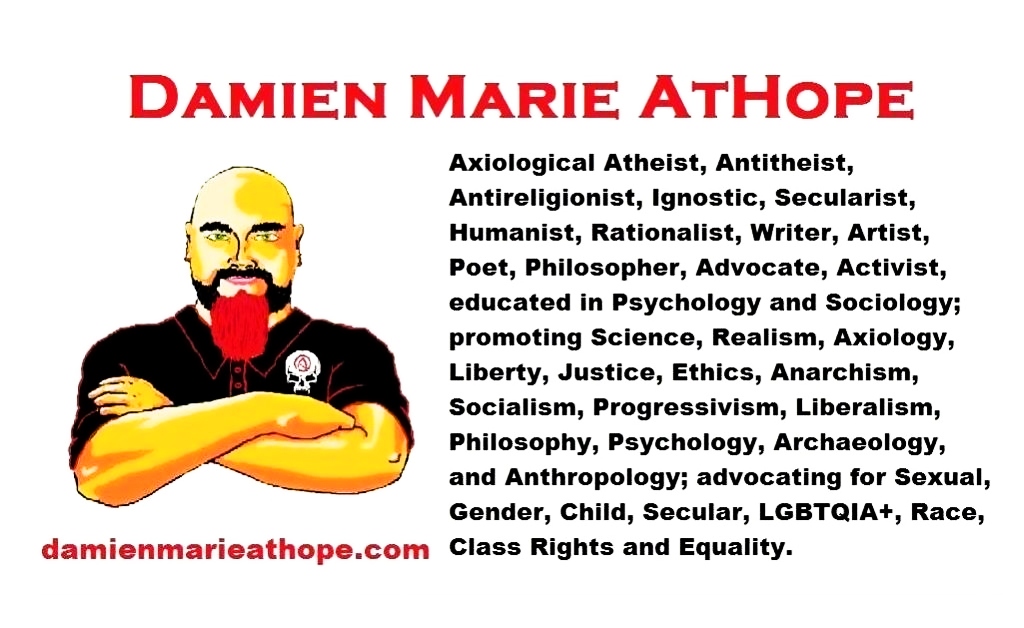
Damien Marie AtHope (Said as “At” “Hope”)/(Autodidact Polymath but not good at math):
Axiological Atheist, Anti-theist, Anti-religionist, Secular Humanist, Rationalist, Writer, Artist, Jeweler, Poet, “autodidact” Philosopher, schooled in Psychology, and “autodidact” Armchair Archaeology/Anthropology/Pre-Historian (Knowledgeable in the range of: 1 million to 5,000/4,000 years ago). I am an anarchist socialist politically. Reasons for or Types of Atheism
My Website, My Blog, & Short-writing or Quotes, My YouTube, Twitter: @AthopeMarie, and My Email: damien.marie.athope@gmail.com
